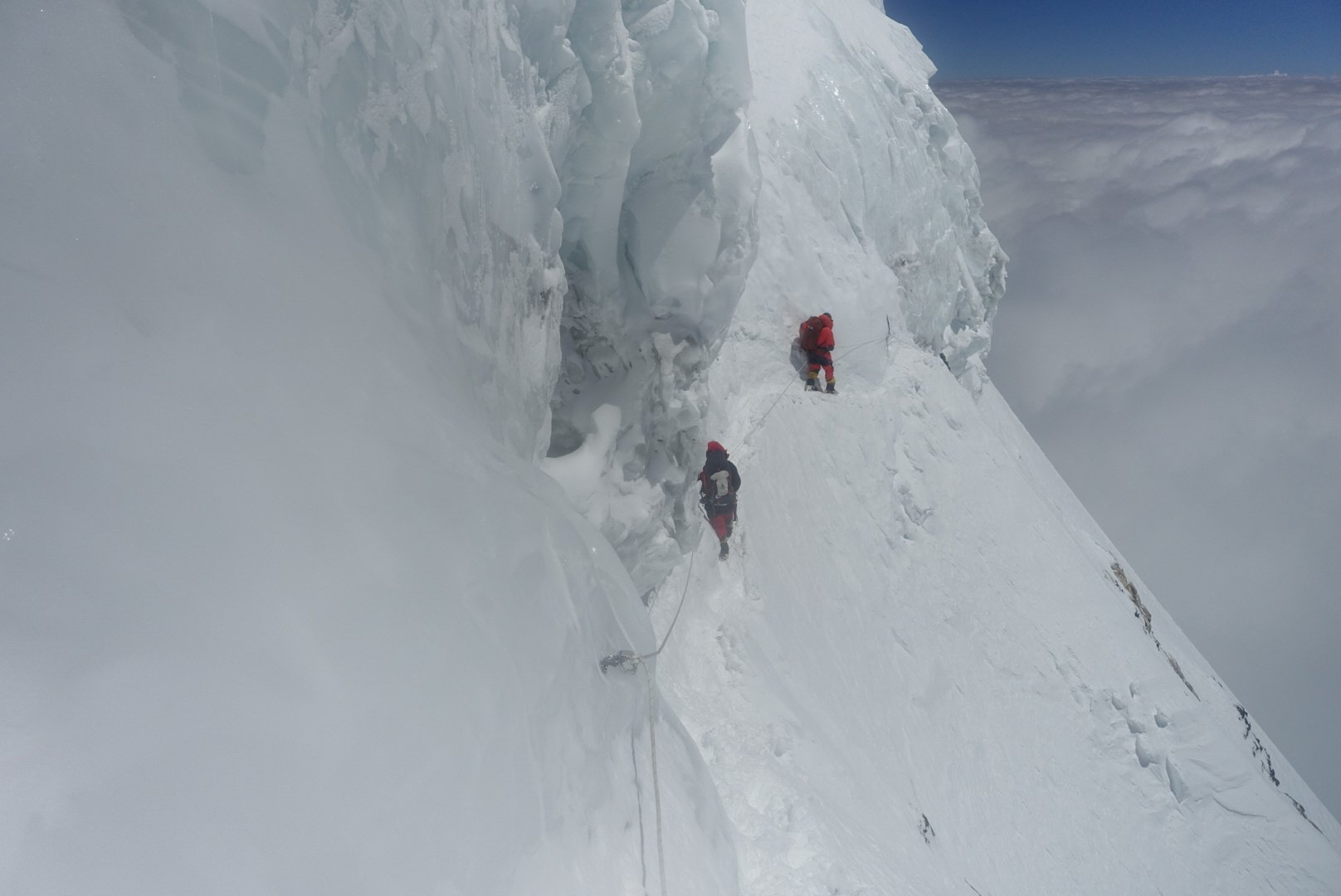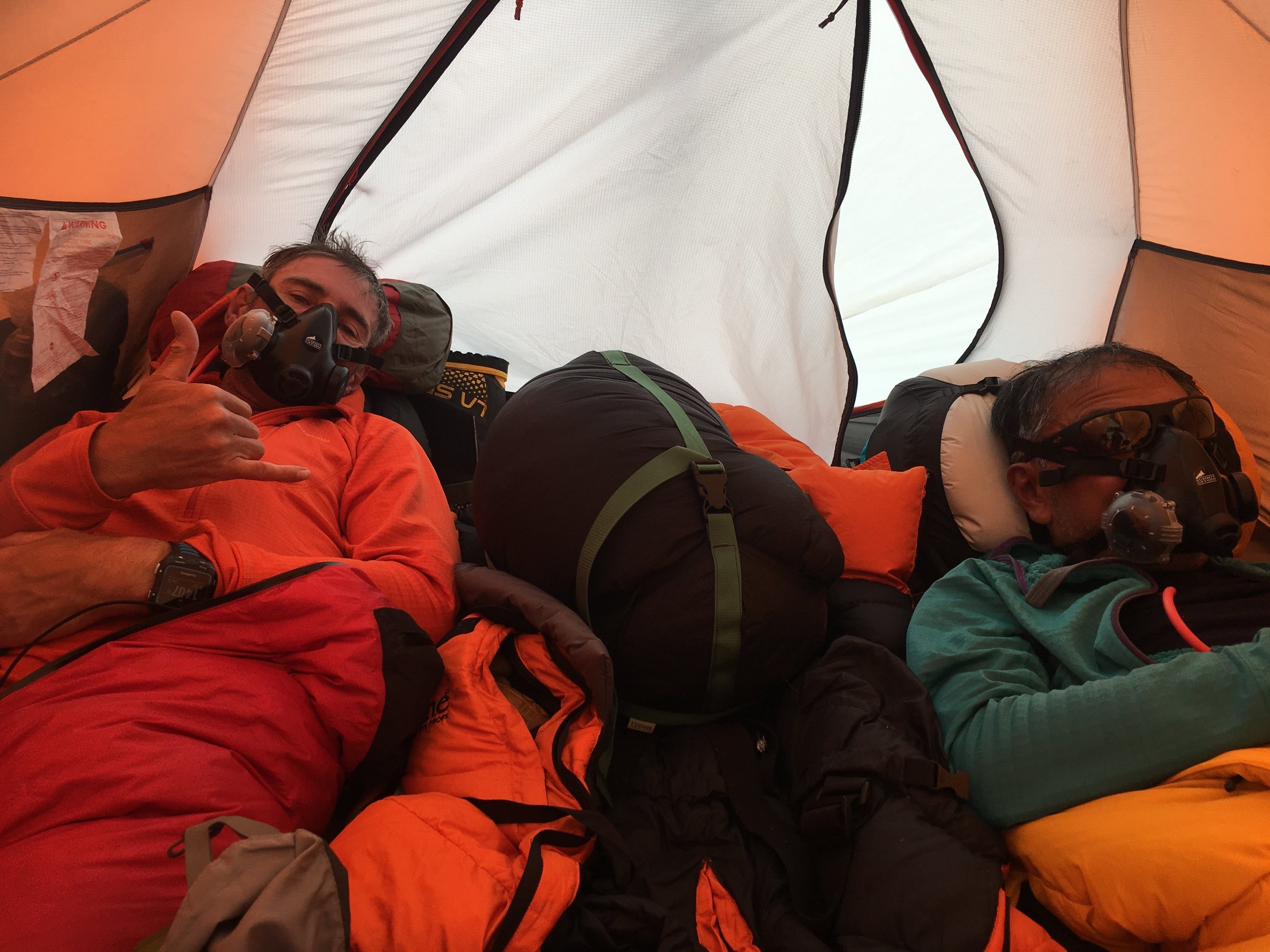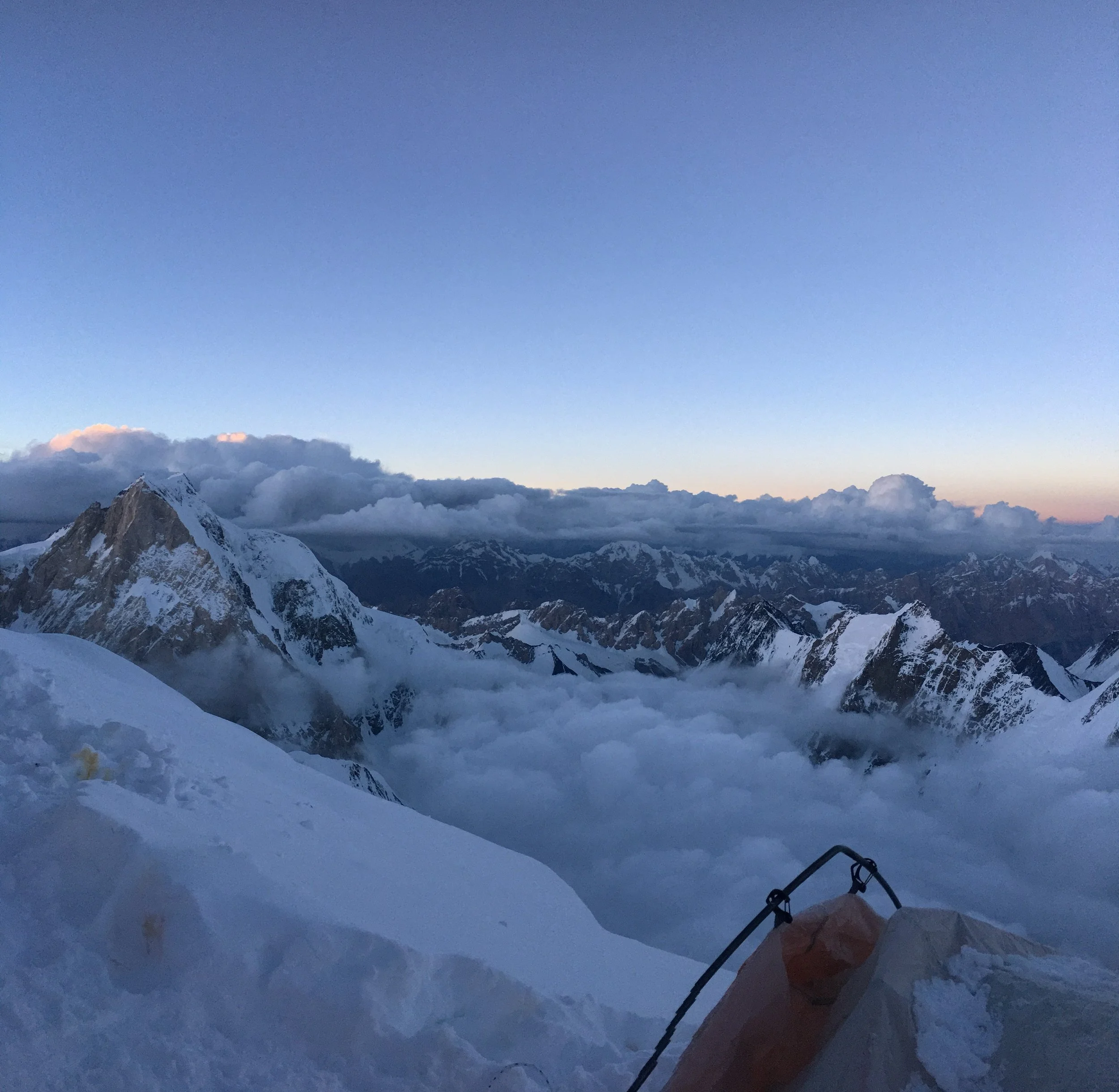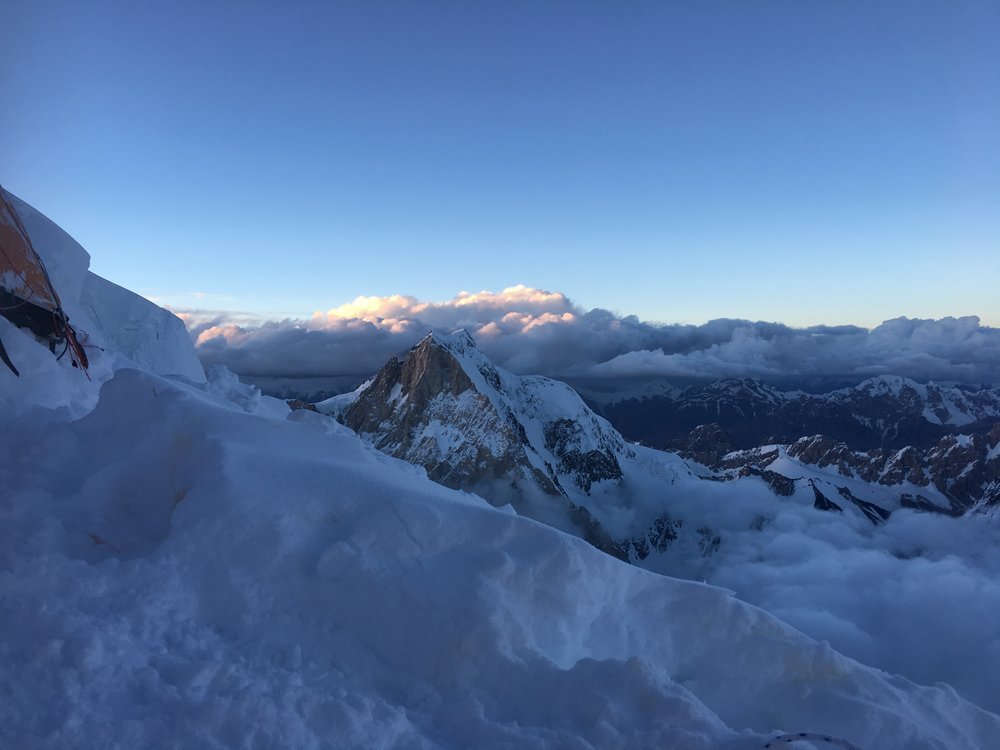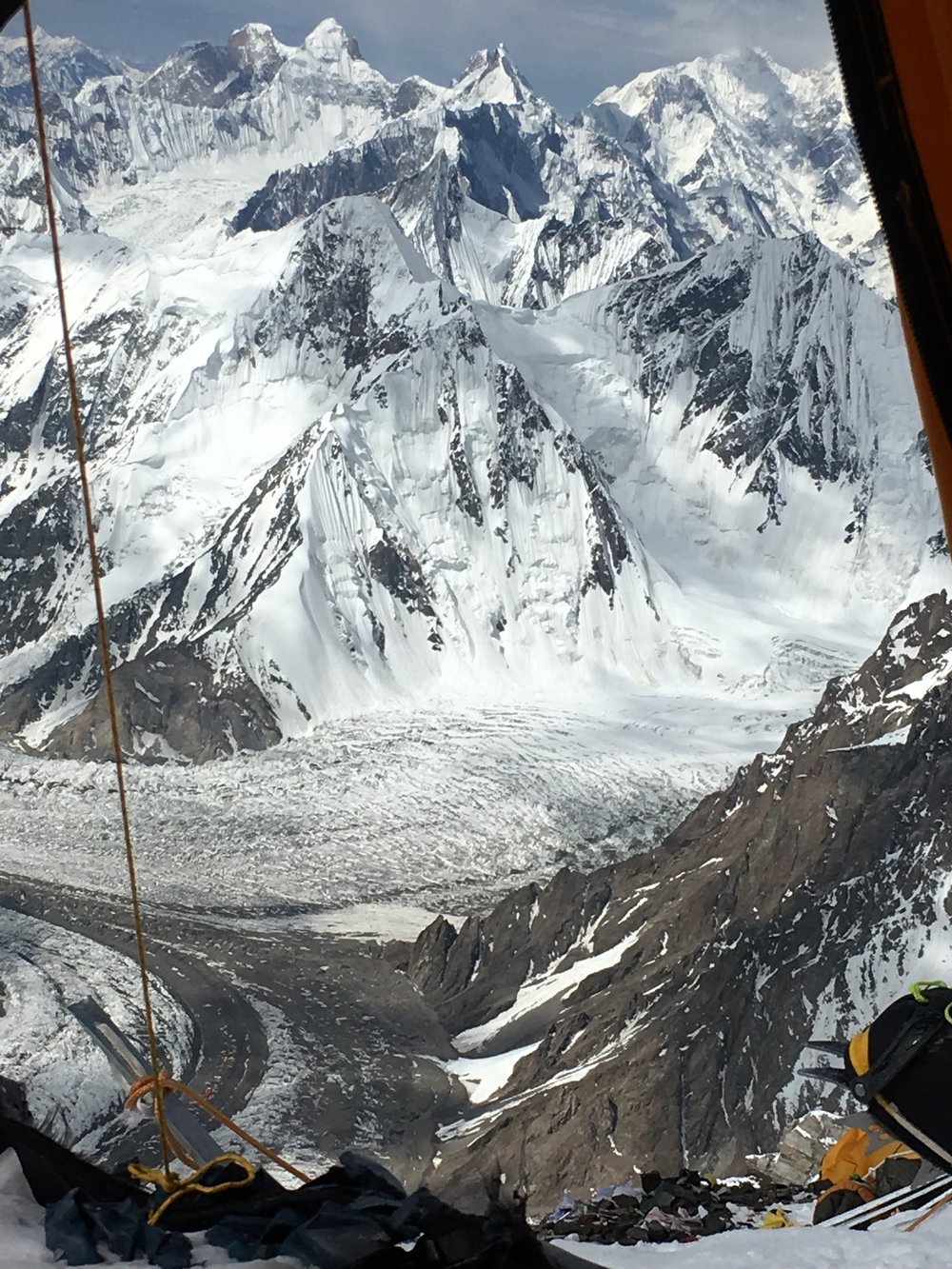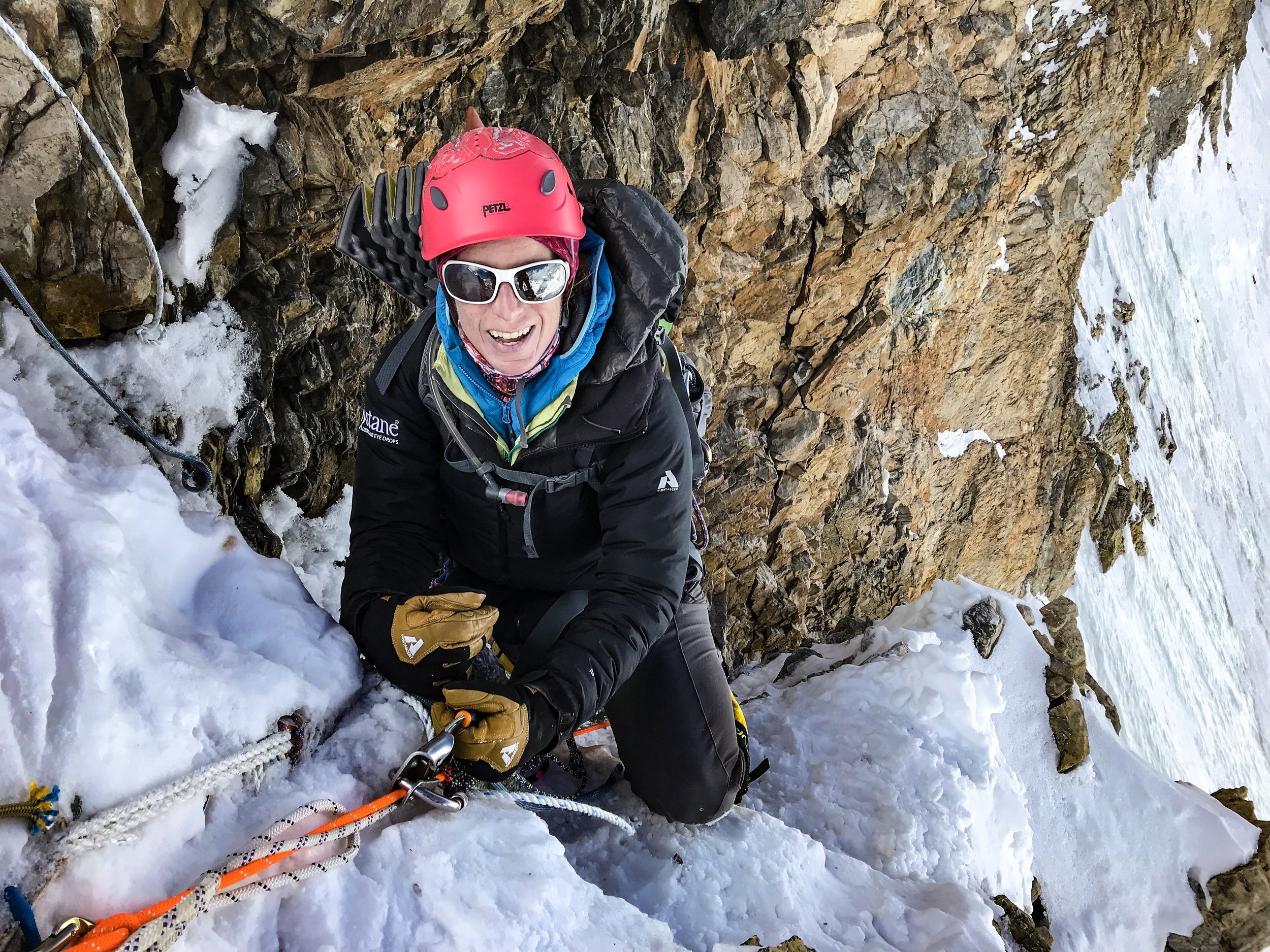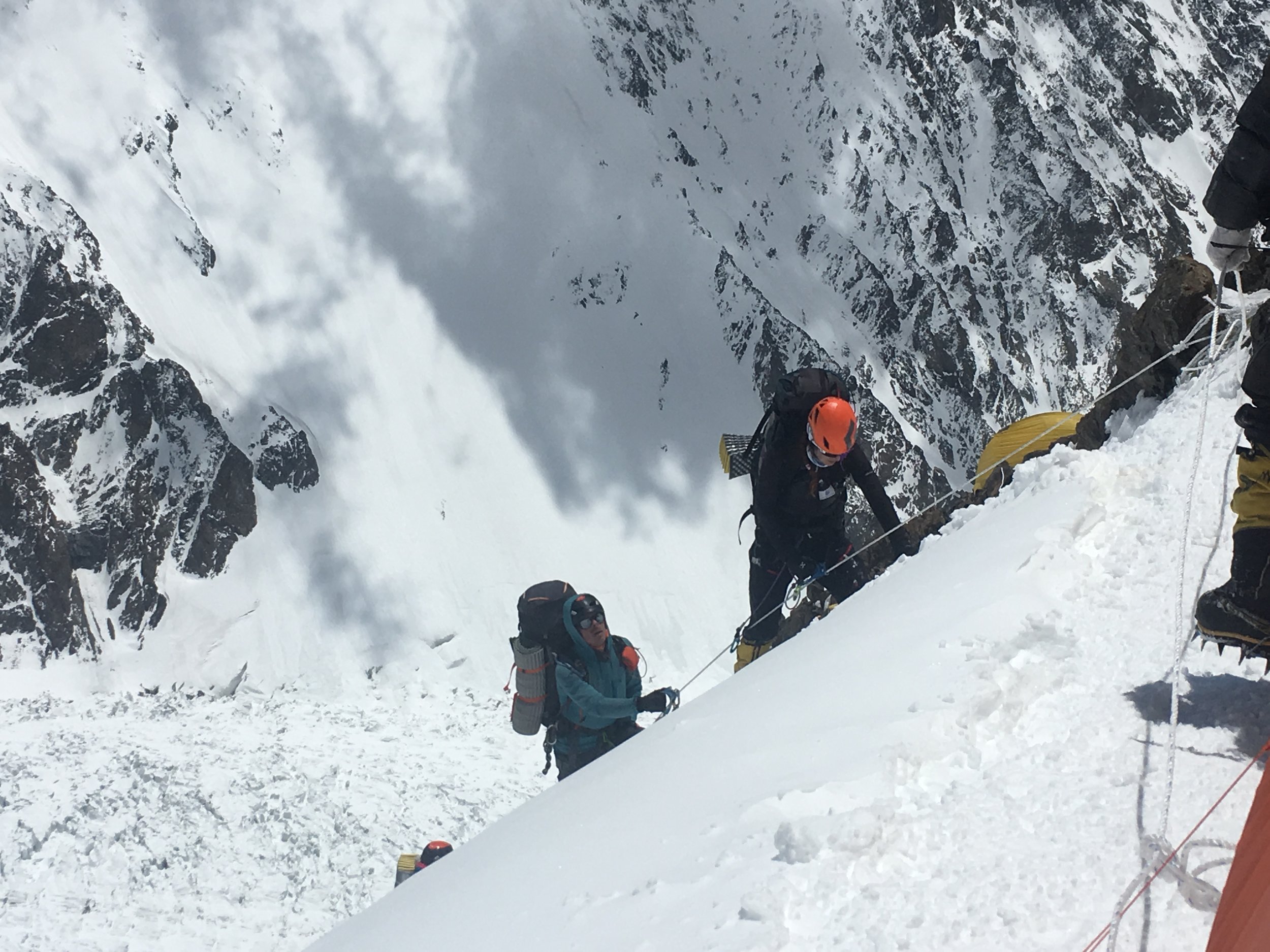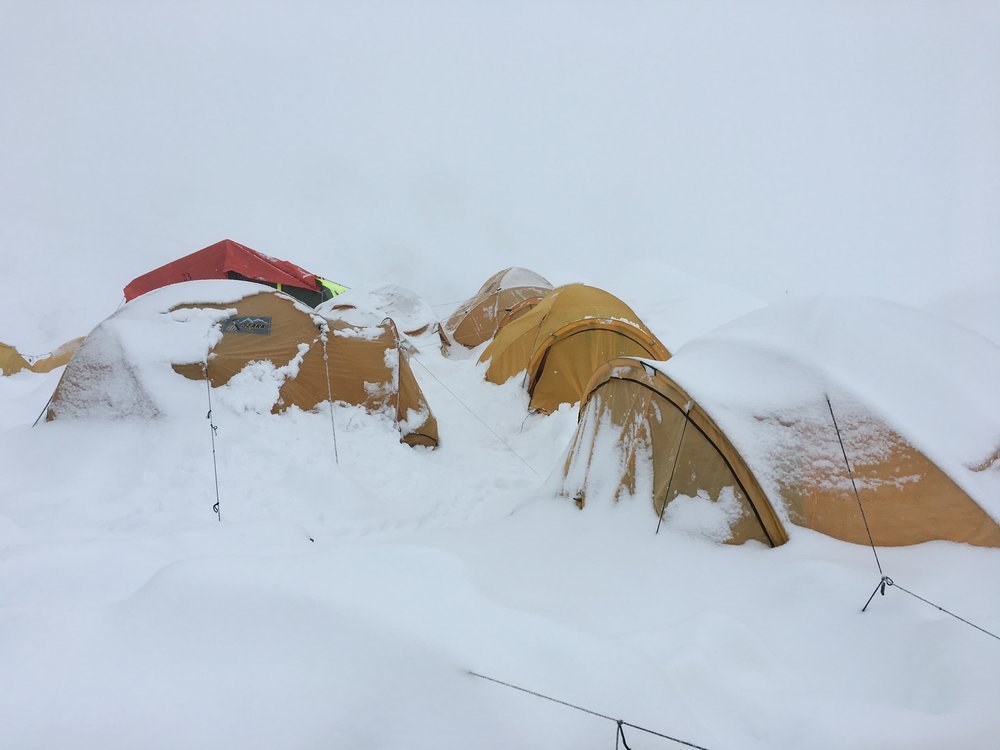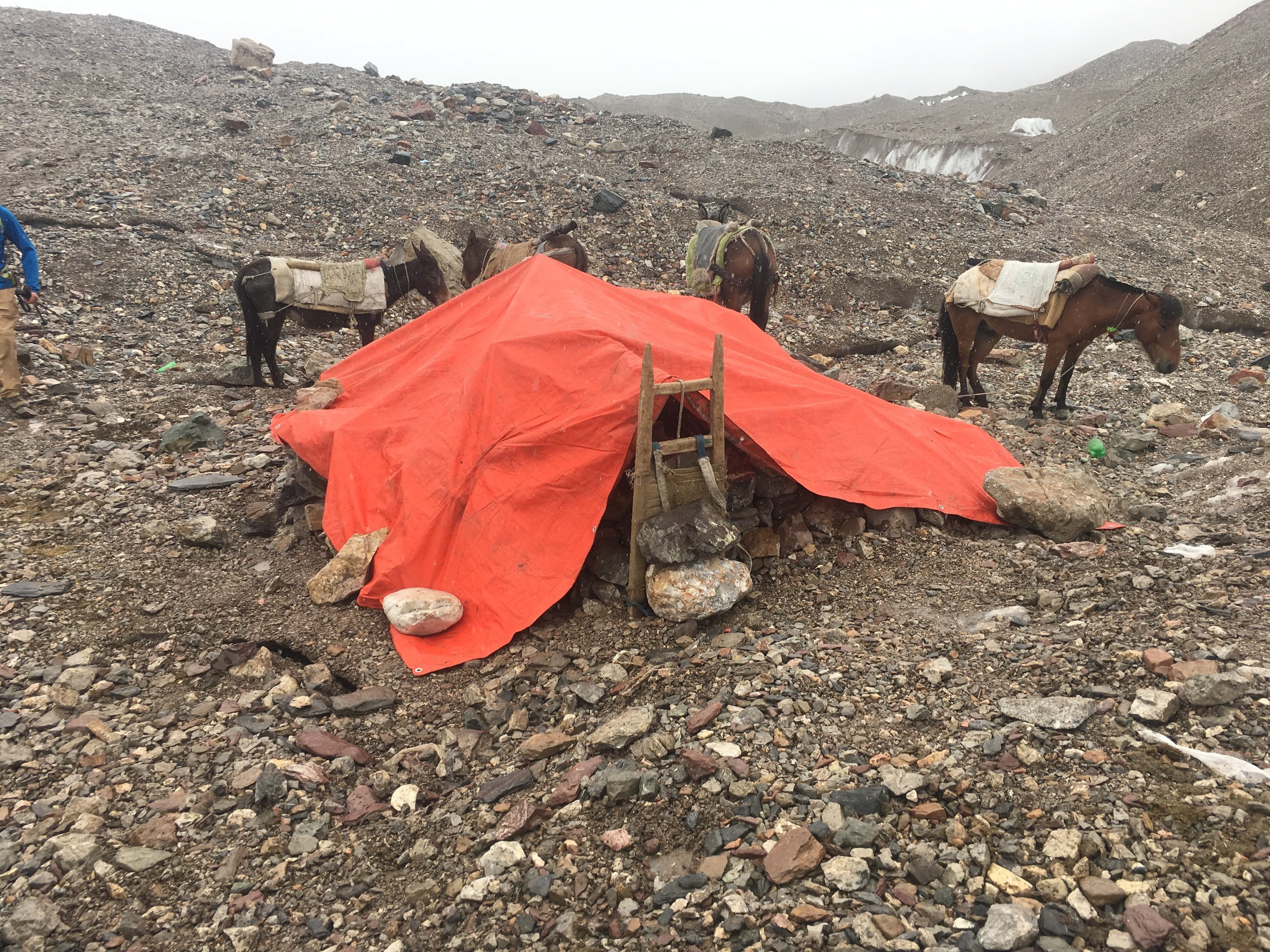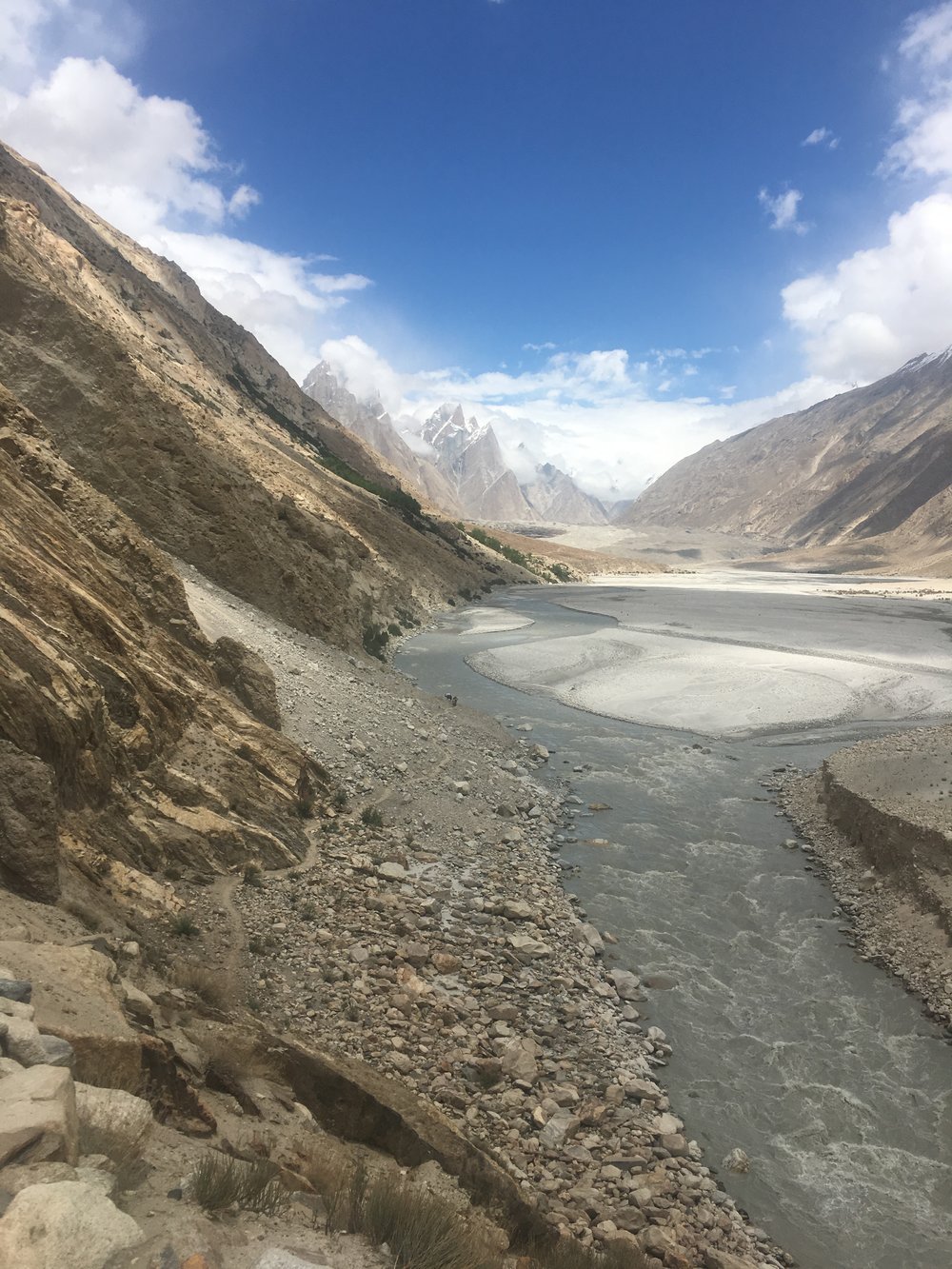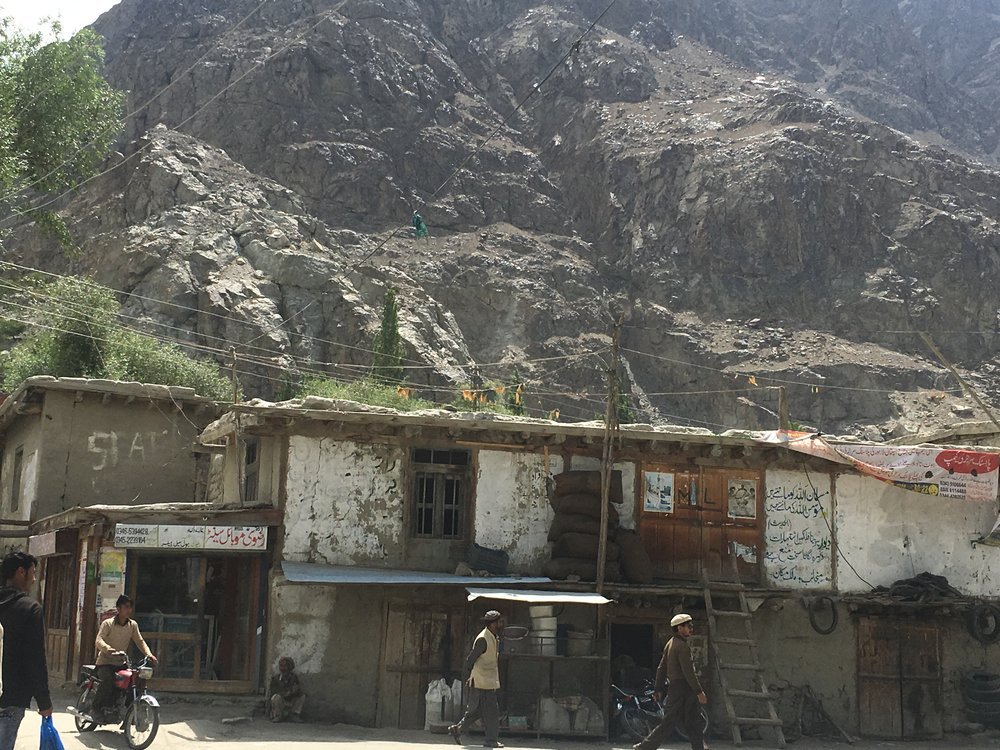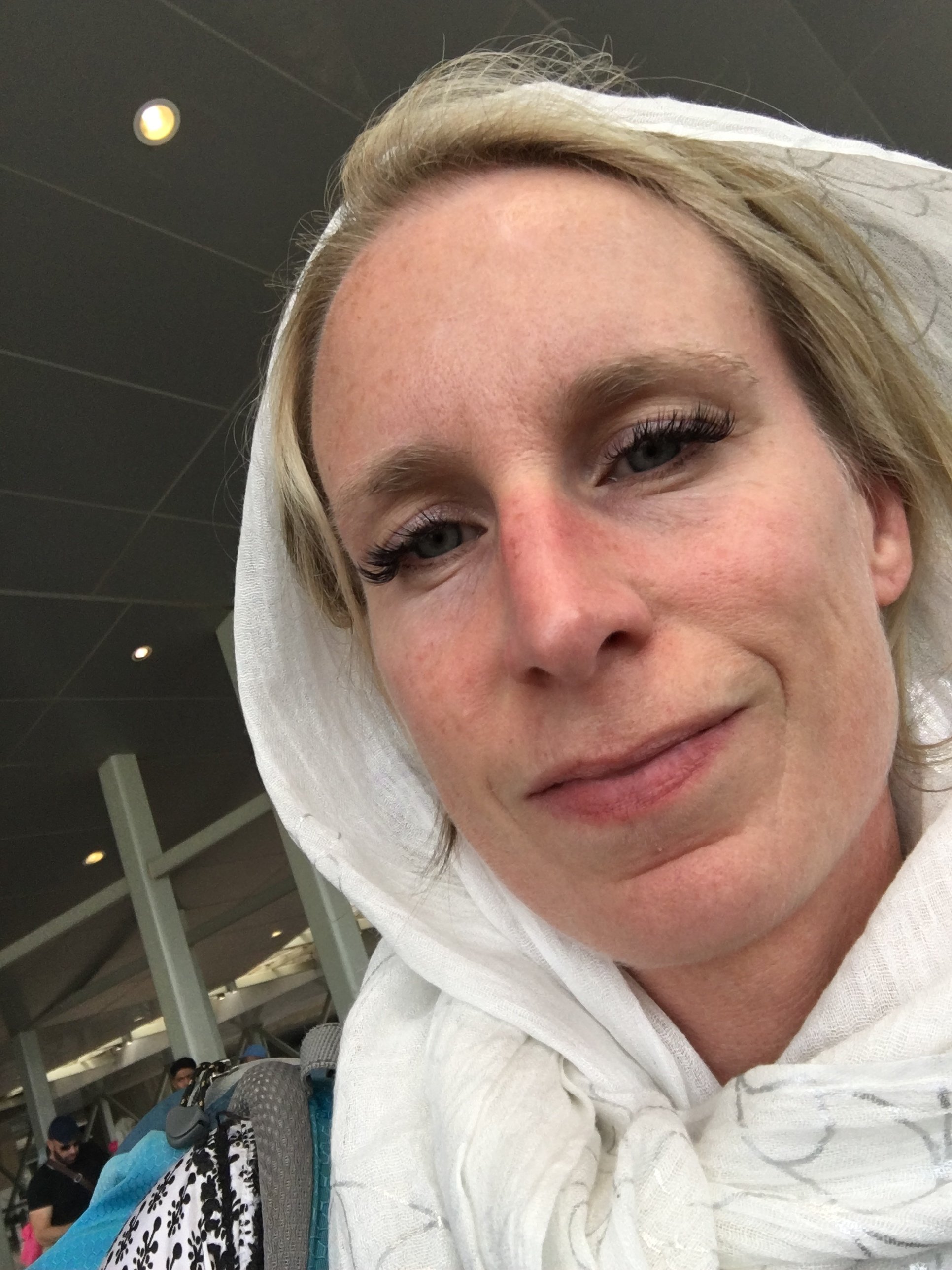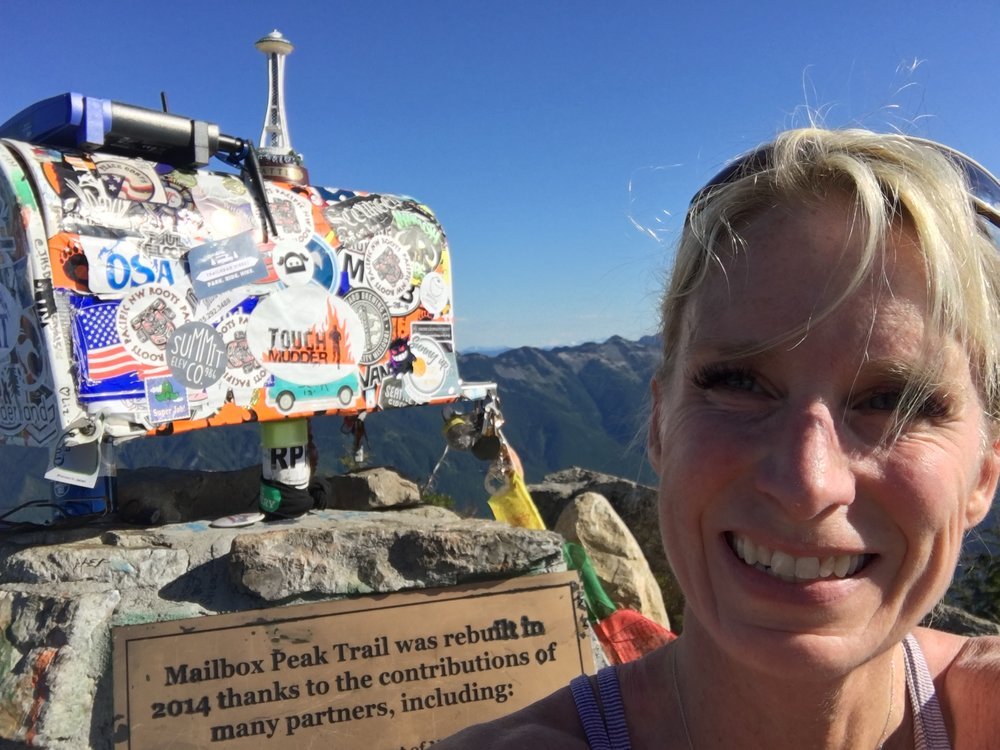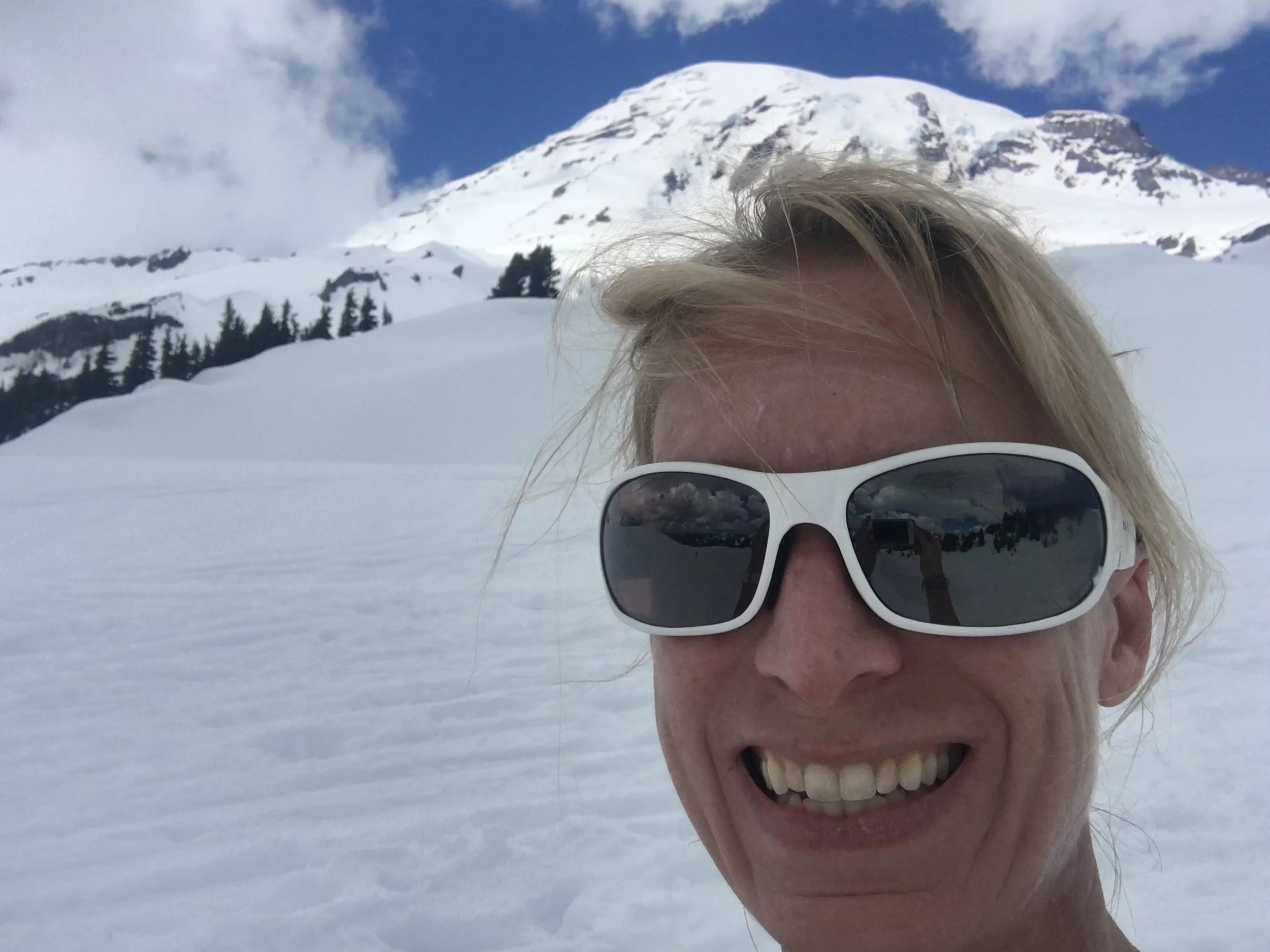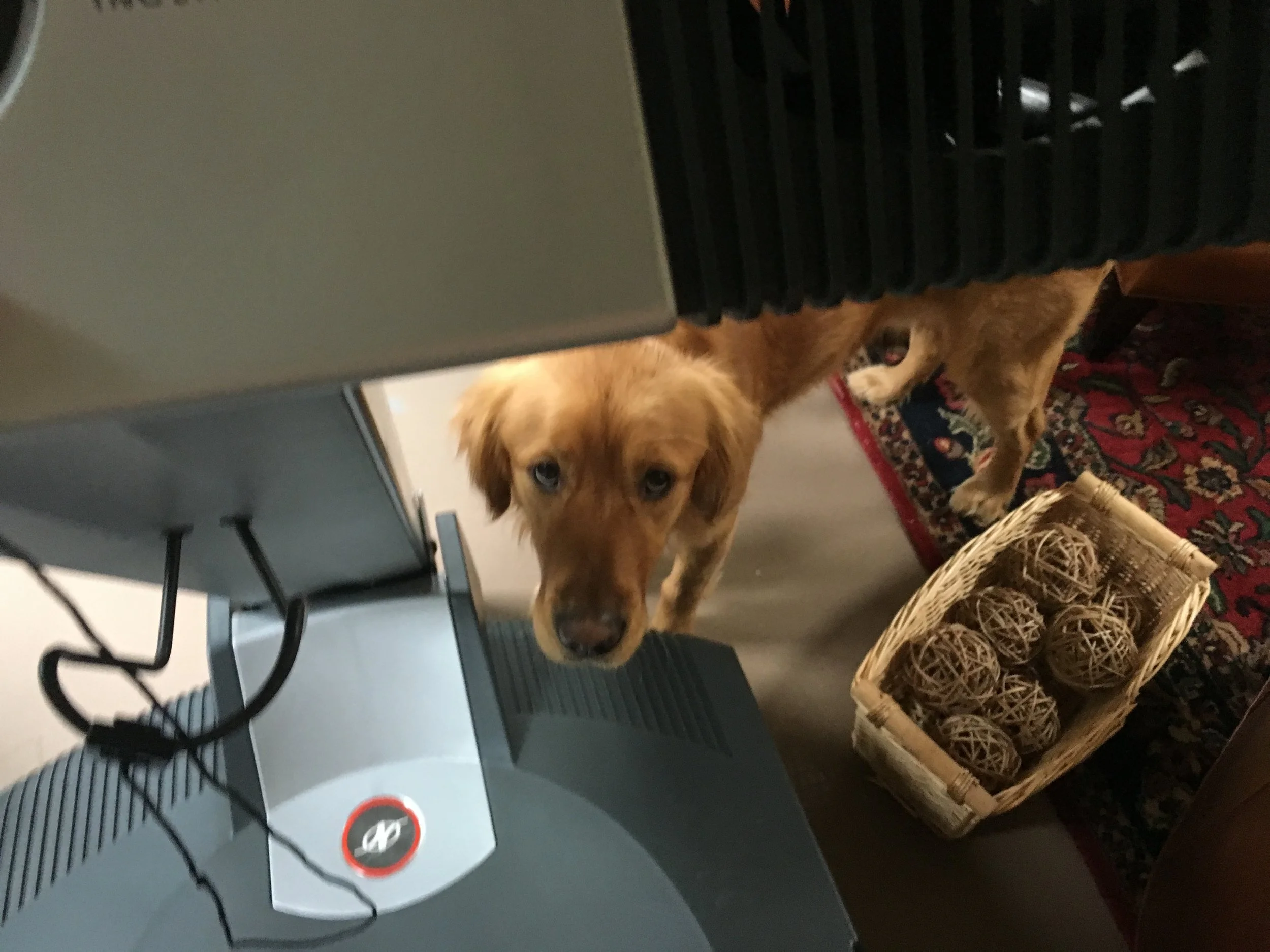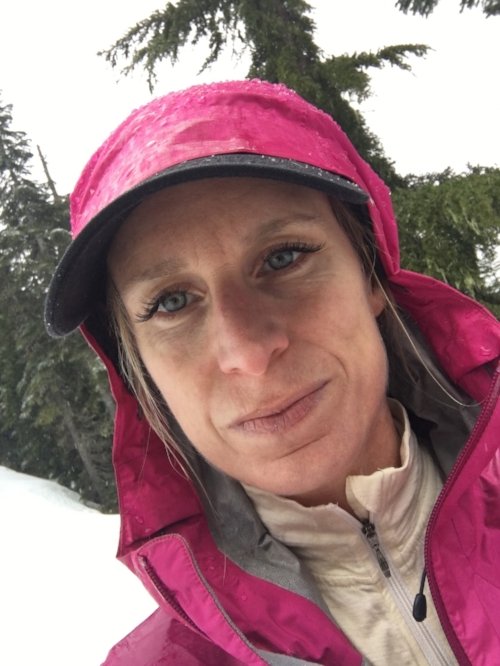K2
Descending from the Summit
July 22, 2018
I have to get it together, I have to tuck away all of those emotions - which I really need to release - and focus on the dangerous job ahead of me.
Every mountaineer knows that fatigue and gravity dangerously combine to make descending the most deadly part of any climb. I am also hyper aware that most of the silver plates at the Gilkey memorial which mark the death of K2 climbers before me are etched with the words "died on descent".
Danger is relatively low on the slope just below the summit but the powdery snow makes it difficult to stay upright and I fall repeatedly. I learn that the faster I move, the easier it is to stay upright. I glance up from my feet for a second and am struck by the view. Ahead of me I can see hundreds of miles of pristine mountains and glaciers. I will never have this view again; I know and I don't want to forget it; I need to relish it. I stand in the snow for a minute and take a few deep breaths.
Standing in the sunshine to admire the view is tempting but I'm still in the death zone and it's time to get back to work. My job is to safely descend 7,000 feet (2100 meters) to camp 2. I have to keep eating, drinking and monitoring my oxygen usage.
Ahead of me I see a green figure slowly moving toward me and realize that it's Rob. Rob is the strongest person I know. For real. During the ascent the tube connecting his regulator to it's oxygen bottle became detached, preventing the flow of oxygen to his mask, his brain, his body. I was climbing behind him when it happened and helplessly stopped for a minute but couldn't offer any support. Lakpa's radio requests for a spare regulator were fruitless so Rob somehow modified an older style regulator to his mask. This retrofit meant that oxygen continuously leaked from the bottle and he could only turn his head in one direction because the hose was too short. I offer encouraging words as I pass Rob but he is hyper focused and hypoxic and he continues forward, only grunting in response.
I just want to get past the traverse and hard ice above camp 4. That's my goal. I feel like I am moving efficiently until I reach the ice slope above the traverse which is jammed with climbers ascending and descending. Thankfully we've rigged a new rope to rappel this section which should remove us from the traffic jam, but when it's my turn to rappel someone has started to ascend the rope that I am rapelling. I stop and scream at him but he's laying on the rope, not moving. Garrett is above me and screams louder at him, the climber's helmet moves slightly but he doesn’t make an effort to get off the rope. I think that he might be asleep. While Garrett continues screaming, I consider my options, all of which end with me sliding uncontrollably down the mountain. This is a mess. A dangerous mess. I rappel closer to the climber and Garrett keeps screaming and finally he wakes up. When I reach him we perform a very delicate dance as he unclips his ascender, stretches around me to reattach it to the section of rope above me, then tries to force his tired legs to climb upward so that he can finally move his safety carabiner above me as well. In the few seconds that I am between his ascender and safety he is leaning against me. If he looses his precarious purchase I will slide with him which will be terrifying but both of our ascenders and the ice screws will hold I rationalize. Even though the traverse is waiting for me, I want to get out of this situation as quickly as possible. There are other climbers on this icy section of the route that are struggling as well and in my view are past their limits. All that I can do is keep myself as safe as possible which means getting out of here.
I round the corner to my left and now can see both the traverse and the giant imposing serac above it. I preferred this section in the dark. There is risk everywhere. Above me the unstable mass of ice looms and below me is thousands of feet of unprotected rock and ice. "No mistakes", I say out loud and confidently step across.
The traverse. Photo: Takayasu Semba
In the hours that followed I double-checked every rappel rig. I tapped carabiner gates to be sure they were locked, I tested ropes to identify the most secure, and when rocks flew from above I thanked the mountain that they didn't hit me.
It was midafternoon when I finally rested at camp 2. I collapsed flat on my back in the tent still wearing boots, harness, and down suit. I didn't want to move but I knew that the struggle wasn't over. There were still plenty of ways to die on K2 and I had to continue taking care of myself. After several minutes I forced myself to put on dry clothes, eat and drink. I snuggled into my sleeping bag and finally let the emotion take over. I don’t remember when I stopped ugly-crying.
Back at camp 2 - no judging!
Summit
July 22 - K2 summit 28,250 feet (8611 meters)
My "rest" at camp 4 concluded around 9 PM. I could hear the camp outside come to life - stoves hissed in complaint of melting snow at 26,000 feet and oxygen bottles sputtered when regulators were attached.
I feel a low grade panic. What if I didn’t have enough water, where was my fresh oxygen bottle, should I wear foot warmers … blah, blah, blah.
At 10 PM it was time to go, the time for preparing is over. The climbing begins with a short but steep hill which momentarily spikes my heart rate. The terrain levels off for what felt like at least an hour and while I am thankful for easy climbing I know that I'm not gaining altitude and not gaining altitude isn't getting me closer to 28,250 feet (6811 meters). I realize that we must be on the shoulder, which is the usual spot for camp 4. I'm tracking time and altitude with my watch because I have calculated that I will need a fresh bottle of oxygen in 5 hours and I am committed to eating at least a few bites of carbohydrates every hour in order to maintain my energy.
Snacking while wearing an oxygen mask, climbing a steep slope, and wearing big gloves is a challenge. It involves first identifying which pocket of my down suit contains the desired snack. Carbs are on the right, chocolate on the left. I wiggle my heavily gloved hand into the pocket and feel around until I think that I've captured a few crumbs of food (everything is loose in my pockets to simplify the whole process). My next goal is to not drop the food which happens about 30% of the time. If it makes it to my mouth I carefully slide my oxygen mask up so that the side of my mouth is exposed and I wiggle the food in, again trying not to drop it. I probably expend more calories trying to eat than I gain by actually eating.
There are several inches of fresh snow on the route despite another team's ascent yesterday. I don't envy the guys at the front of our team who are breaking trail. We're all following one another closely, all using the fixed line, and I notice that my headlamp is not as bright as everyone else's. I find the headlamp's button with my gloved index finger and click through its modes but it doesn't get any brighter. Thankfully Lakpa is behind me and I can kinda see better with his headlamp sweeps across the slope. I am pissed that the fresh batteries I installed just a few hours ago are failing but know that there is another set in my pack. I manage to steal light from my fellow climbers as mine fades to black. I don't want to stop to change them until the whole team stops for a quick break. Just before the terrain steepens we do stop just for just a few minutes. I give up eating to deal with the headlamp. Regretfully taking off my gloves to do so more quickly. Someone told me once that if you take your gloves off in haste you risk doing everything else slowly for the rest of your life.
The snow slope steepens and I know that I'm climbing the bottleneck, a slice of snow between two rock masses. The bottleneck is as steep as 80 degrees in places and the whole team slows in response. Climbing slowly in this space is not desirable because we all know that looming directly above us is a fragile mass of ice and snow larger than an office building. I refuse to think about the deaths that it has caused. The light from my headlamp starts to weaken again. The light itself is probably freezing and I swear that I will buy one with an external battery when I get home. I can climb the bottleneck with deficient light but I won't attempt the sketchy traverse that way. That'd be suicidal. Using hand gestures and broken sentences I begin asking my team mates if they have extra batteries or an extra headlamp. I hate this. I hate making my problem their problem but I can't come up with a better option. The team slows before the traverse and Rob graciously hands over his batteries, and helps me install them in my headlamp. I can see again and when I glance up the light from my headlamp bounces off a wall of ice as far as I can see. Maybe it was better not to know.
The traverse is skinnier than my foot in places. I stand on its precipice watching Rob expertly cross and notice the snow crumbling down the slope into darkness with his every step. Then I think that I see him step over the fixed line. That can't be right. But then he steps over it again when he reaches the other side. I'd visualized the traverse many times and it never involved cartwheeling over the rope. Deep breaths. I move my ascender and safety carabiner to the next anchor and step across. I really don't remember what happened after that point. I presume that I just focused on the circle of light from my headlamp and delicately inched across.
Above the traverse is solid ice. Hard ice. The kind that your front points want to bounce off of. I kick in as hard as my legs will allow and look for little dimples in the ice that will aid my movement. Above me Rob is doing the same. Every time I look up I see the glare of more steep ice, but as I look over my right shoulder I can start to see the horizon lighten and I am thankful for the promise of warmer temperatures and sunlight.
Eventually there is a gentler snow slope and the team has spread out a bit now as folks are stopping when they can to eat and drink and rest. Above this gentle slope is a ridge and I sit in the snow with Lakpa and three other teammates. When I look up, in the daylight now, I see steep snow and a line of dark dots slowly moving up it in unison. I check the altitude on my watch and consider that this could be the final push to the summit but I've been fooled before by mountains so I don't get excited. Even the part of the slope that I can see from this vantage point will take hours to climb so celebrating would be foolish.
I shoulder my pack and start walking, my goal to catch up with the last climber in front of me. The slope steepens again and is covered with about a foot of fresh, sugary snow. Making progress is now mentally and physically excruciating. Everyone is slow and I use the time waiting to shove chocolate crumbs in my mouth. After a while - I don't know how long because I've lost the energy and motivation to track time - I look up and think that I can see a long ridge to the left. I realize that could be the summit. It probably is the summit. Of K2. Emotion starts to well inside of me but I push it back down because I can't afford to lose focus now. The familiar fog of oxygen deprivation also creeps into my brain and I realize that my bottle is nearly empty. I decide to push forward to the summit to change it there.
I've never experienced a euphoric moment on the summit of a mountain. I wish I could say that I had but I am much more practical. The summit of K2 is long and narrow and when I joined my teammates there I had three things to do: change my oxygen bottle, spread my dad's ashes, take photos.
On the summit I kneel in the snow and unzipped the top of my pack. I'd been carrying my Dad's ashes there for two years and have sprinkled them on nearly every summit since. Dad spent his whole life in the flatlands of Illinois, so the idea of climbing into the clouds was foreign to him. I know that it scared him immensely that his oldest daughter spent so much time in dangerous environments. But he was always proud and always supportive of my mountaineering accomplishments. I learned that he had stage 4 lung cancer after I summited Everest. Cancer had taken over his body and most of his mind by the time I returned home from Nepal but with a raspy voice he managed to ask me if I was done climbing mountains. "There's just one more" I told him. It seemed very fitting that I was now releasing the last of his ashes on that last mountain.
Jason is to my right, making a satellite call to his teenage daughters. Through tears he tells them to never give up because they can be anything that they want. I know that these are my dad's words to me too. And now I am flooded with emotions that I can't hold back. My forehead falls to the snow and tears stream down my cheeks and freeze. After a few minutes I stand, now next to Jason. We silently hug and cry. There are so many words that I want to say to him, a million ways that I want to thank him for encouraging his daughters to be strong women but in this moment my hypoxic mind can't make my mouth work so I turn to descend.
Camp 4
July 21, 2018 - camp 4 26,025 feet
It's hard for me to believe that I'm lying in a tent at camp 4 on K2.
Took less than three hours to get here, despite deep powdery snow, which I was honestly disappointed by because it was a signal for me that camp 4 is lower than it's normal location. A lower camp 4 means that we are further from the summit and will therefore will have a longer summit day tomorrow as we’ll have to climb about 400 more feet than usual. I know that this doesn't seem like a lot, but every step counts.
As the team arrived at camp 4 today, the team that we've been trailing was descending from the summit. They really looked strong, not tired or beat up by the mountain. I made it my goal to look and feel the same tomorrow. We waited in the snow for them to vacate our shared tents and then dove in ourselves. We're now organized three per tent, I generally take the middle position in this situation, because I am the smallest and create a buffer for my male tent mates. It's also warmer to be in the middle.
Cozy at camp 4 with Jason and Semba
Jason, Semba and I are lying flat on our backs, fully dressed in down suits and boots, wearing oxygen masks. We look ready to start climbing, but in fact I feel like I have a lot of work to do. Primary on my list is to eat and drink. Thanks to Jason's (https://www.jasonblack.ie/k2/) expert nutrition advice, my focus is on consuming carbs, mostly in the form of Pakistani flat bread called chapati. I've been carrying this chapati in my backpack for four days so it's more like chapati crumbles. I finished with a chocolatey delicious bar-in-the-jar (http://www.barinthejar.com/order/) because chocolate is it's own food group and shouldn't be excluded from any meal, especially at 26,000 feet. In a couple hours we'll all have soup. My appetite is better than expected, and luckily I am able to force myself to eat when my body isn't interested. Aside from eating and drinking, I’m double checking the chocolatey carby snacks in the pockets of my down suit, and memorizing which food is stored where. I’ve replaced the batteries in my headlamp with new ones, and tucked another fresh set in an inner pocket so that they (hopefully) won’t freeze. I still feel like I’m forgetting to do something important.
The weather forecast for this evening and tomorrow looks really good, which is unbelievable for K2. The snow has tapered off, and winds at the summit should be around 15 knots, the temperature -17C. That probably sounds horrible if you're reading this from sea level, but at 28,000 feet (8,600 meters) those are perfect conditions. I can't imagine any reason that we wouldn't follow our current plan, which is to leave camp 4 around 10 pm.
Although I have been preparing for and thinking about this moment for years, I feel apprehensive and a bit nervous. Regardless of how much I've trained for this mountain, there are so many unknowns ahead of me and it's easy to get stuck thinking about "what if". So, instead I am going to spend the rest of my time at camp 4 soaking in all of the love and support around me, and visualizing my safe summit and descent.
Camp 3
July 20 - camp 3 - 24,000 feet
Rock climbing at 24,000 (7,300 meters) feet while wearing crampons and a down suit SUCKS.
There's only one obstacle between camp 2 and 3. It's 1,500 feet (500m) of unstable rock and ice. The black pyramid, as it's called, is not only exposed but includes vertical sections of rock and ice, one of which was aided today by a steel rope ladder. Even with the benefit of supplemental oxygen climbing up here was hard. Really hard. Several times my body wanted to stop. And each time I asked myself "Is this all that I am capable of?" And each time my honest answer was no. So I kept moving. It helped to shift my focus to how my body was moving on the tricky terrain. I'd scan the rock above me and look for the best place to put my free hand (while the other clenched my ascender). Next I'd look down between my legs to find the best chunk of rock to balance my crampons. Then I'd breathe. And breathe again.
I was initially relieved when I finally reached the top of the black pyramid and the rock gave way to snow. But unfortunately climbing on steep powdery snow wasn't much easier. All of the fresh snow that's accumulated over the past two days is loose and sugary and one step up often leads to sliding backward for several feet until either my ascender or snow accumulation under my boots stopped my slide. This was more mentally challenging that physically because I felt like I wasn't progressing upward. By early afternoon the clouds became so thick that when I looked up all I could see was a wall of white pierced by the bright orange rope of the fixed line. I found some comfort in this sensory deprivation. It was comforting to just be in my bubble and not consider the challenges above me or the free air below me. In fact, I couldn't even see camp 3 until it was right in front of me. Seeing the smiling faces of my teammates and knowing that I'd safely climbed the black pyramid lifted my spirits instantly.
Inside my tent, I took my oxygen mask off as I unpacked my sleeping bag and food. When I was done, I measured my oxygen saturation. 53%. As a point of reference, if I were at home I would be admitted to the hospital if my oxygen saturation were less than 90%. It's laughable that I felt satisfied when I put my oxygen mask on and it shot up to 70%. Oh my poor brain cells!
Although it's cloudy now, it's hardly snowing and reports from above sound like we should be able to complete the short climb to camp 4 tomorrow.
Camp 2 - Still
July 19 - camp 2 21,450 feet
K2 is fickle, and even though we have the best forecasts available the mountain is in control of what ultimately happens, and we have to be smart and adaptable. I spent most of last night listening to snow pile up outside the tent, eventually sounds were muffled and I knew that the tent was completely covered. When I reached a hand outside my warm sleeping bag and slapped the tent wall closest to me my heart sank as I watched inches of fresh snow slide down the side, I knew there was much more than the predicted 3 inches (7 cm).
Motivation is scarce at 21,000 feet (6,400 meters) but eventually I peaked outside the tent to confirm that there was a foot (30 cm) of new snow. I knew that our move up the black pyramid to camp 3 was now questionable, and radio conversations with the team above us and the Sherpa team above them confirmed even more snow higher on the mountain. Feet of fresh snow is an avalanche hazard, especially on the steep slopes above us.
I laid back down in my sleeping bag and waited for what I knew was coming, we were descending. I began packing and gearing up and was mad, really mad. Not at anyone, not at the mountain, just at the situation. I was minutes away from stepping outside of the tent to put on my crampons and begin descending when someone on the team, I don't know who, questioned the decision to descend.
I think that I experienced every emotion in the next few minutes. Everyone on the team argued their opinion and eventually we agreed to wait at camp 2 one more night to see whether the mountain would allow us to climb higher. Even without the benefit of hindsight (which I have now), this was the right choice. We have enough food and fuel to extend our summit rotation by one day, the weather forecast from a new source calls for improving conditions beginning tomorrow for the next 3 days, then poor conditions beginning on the 24th.
It's late afternoon and it's overcast and snowing lightly. I'm trying not to spend too much mental energy willing snowflakes back into the clouds. Fingers crossed that we can move to camp 3 tomorrow.
Camp 2
Camp 2 - 21,450 feet
Today K2 reminded us that she is in charge. There were about 6 inches (15 cm) of fresh snow at camp 1 when I woke up this morning. Six inches isn’t enough to prevent us from climbing, but because our movement depends on another team whose tents we’re sharing, we waited for a couple of hours to be certain that they were moving up the mountain so that we could occupy the tents they vacated at camp 2. Thankfully, after many radio conversations in English and Nepali we confirmed that they would climb to camp 3 today.
When we began climbing it was snowing lightly but within an hour that changed to full-on blowing for the next three hours. I was quickly wearing all of my extra layers and still chilled, but not cold. Although there is only a thin layer of nylon separating me from the weather outside, I feel comfortable and warm in this cramped tent.
Fingers crossed that the mountain allows us to climb the black pyramid to camp 3 tomorrow!
Camp 1
July 17, 2018 - Camp 1 19,700 feet
Sometimes I feel like I will safely summit this mountain, and sometimes I feel like shit. My perspective can change in minutes. I really don't feel like I have acclimitized as well as I should have after almost three weeks above 16,500 feet but there's not much that I can do about that now. Today I was taking three breaths per step most of the way to camp 1. Counting steps is abysmal, and usually only serves to make the route feel more monotonous than it actually is. So instead, I think "step, step, slide" (slide referring to the movement of my ascender up the fixed line). This phrase becomes a meditation for me and I am usually able to turn off all of the chatter and pain in my brain. Today I decided to switch my mantra to "step, step, strong". A small thing perhaps, but if I'm going to be forcing my thoughts, they might as well be positive!
Klara and I are sharing a tent up here at 19,700 feet and it's a bit comical. Real estate at camp 1 is more than sparse and the slope is steep. So steep that I need a harness to prevent rolling down the mountain when I go to the bathroom. I'll spare you the details. Back to our tent situation … we're sharing tents with another team which means that we’re moving up the mountain a day after them and sleep in the tents that they've just left. There's always interesting things left behind, like chop sticks and pee bottles (ugh!) but the most exciting thing is that we're using rolled-up tents on the floor of our tent to level it (in case you're thinking of trying this, it doesn't work). Also the tents are soaking wet. Klara unfortunately is on the downhill side of our soggy, crooked tent and I am constantly sliding into her, pushing her into the side of the tent. Which is concerning because there is a label on our tent which makes me think that it's been in use since 2009! I'm worried that the aged nylon will rip and we'll both pop out.
I had another special surprise today … my period. I hope that's not too much info, that's just what happens when you're a girl and you climb mountains!
It's snowing now as predicted but the plan is still to move to camp 2 tomorrow.
Climbing to camp 1
Summit Rotation Begins
July 17th - Advanced base camp
The summit rotation. It's hard to believe this is happening. Aside from some nasal congestion, I feel strong physically. Mentally I still waiver. And I am really, really trying to focus on only the things that I have to accomplish today. Sometimes I have to filter my focus to just the things that I have to accomplish in this moment.
Klara - my amazingly strong and positive Czech partner - and I decided to spend one night at ABC again on our way to camp 1. The rationale is the same as the last time: it allows is to sleep higher on the mountain and eliminates the need to depart base camp at 3 am (as we would do if we climbed from BC to C1 in one push). Mostly my decision was based on sleep.
Despite hours of packing and discussing gear at base camp, Klara and I both forgot that our eating utensils are at camp 1, while we’re thousands of feet below at ABC. Klara, ever resourceful, scrounged around the rocks and snow last night until she found two discarded tent stakes, which are now our spoons:
Rest day at Camp 2
July 10, 2018
It’s a 'rest' day at camp 2. Resting at 21,450 feet basically means lying in a tent forcing yourself to breathe. It also affords a lot of time to contemplate. I've created a list of the things that I miss: soap, salads, my dog, my friends, chairs.
I've also spent hours today thinking about why I am here. Admittedly, I should have done this before I bought a plane ticket to Pakistan but, better late than never I guess. I've devoted years to preparing for K2. I’ve redecorated my house with photos of its routes, I've willingly given up sleep, dinners with friends, and most of my free time to ensure that I am as mentally ad physically prepared as possible. We are used to the principle that if you set a goal and work hard, it will likely be yours. But climbing isn't like that. K2 doesn't care what I've given up, how committed I've been to it. I am completely irrelevant to this mountain. To any mountain. Further, I've been beat up, disappointed and ignored by mountains many times. So why do I keep coming back?
Because I've also experienced the deepest sense of accomplishment that I can imagine. And I hope that I've been an example to others that big dreams can be realized despite formidable obstacles. The mountains have taught me that those obstacles aren't meant to prevent my success, they are just a part of the process. And, if I work hard and paying attention, I am a slightly better version of myself when I reach the other side of that obstacle.
Camp 2
July 9, 2018
I can't believe that I am lying in a tent at camp 2 on K2, it feels terrifying and exhilarating at the same time. And the view. Wow. The expansive view of the Baltoro Glacier and the Godwin-Austen glacier twisting toward each other to meet at Concordia is awesome. So often we are traveling on glaciers, and they feel static. We forget that they are constantly moving. And in the case of the Baltoro and Godwin-Austen, they are always moving toward each other. From here their confluence looks graceful, but I doubt that it is. Tons of ice and rock slowly colliding can’t be.
The terrain on K2 has shifted from snow with some rock to an even mix of the two. Although it was difficult, I appreciated the rocky sections today because it felt good to really be climbing and because I had to engage my mind to think about how my body was moving on the steep, jagged terrain. Also I finally get to use my upper body. I didn’t do all of those pull-ups for nothin'! I found that big, exaggerated moves where I didn’t have a clear plan for how my body would move were exhausting but that if I can took my time and moved with purpose, I felt better. I was contemplating this in a semi-hypoxic state somewhere around 21,000 feet (6400 meters) and decided that is true of life, at least for me. I generally feel more confident when I have a plan.
House's Chimney is the crux of the route to camp 2. I knew that we were getting close to it based on the elevation reading on my watch, but when I looked up all that I could see was an impenetrable wall of jumbled rock. Finally I saw other climbers on top of the wall which meant that I was staring directly at the chimney but still couldn't distinguish it from the rest of the terrain. I can’t imagine Bill House and Charlie Houston standing below it in 1938 and deciding to give it a go. Oh, and then free climbing it. This lore had painted a larger than life picture of House's chimney in my mind. I knew that it is a 100 foot (30 meter) chimney of poor rock and ice that would be rated 5.6 as a free climb. But somehow I still imagined it to be impossibly heinous. I found it more fun than heinous. In fact, if it were at sea level instead of nearly 21,000 feet (6400 meters), it would have been 100% fun. Getting to the chimney was a bit tricky as a slope of hard ice created a slippery ramp to its entrance. I repeatedly slammed the front points of my crampons into it but usually found no purchase. I had much better luck resting my front points into the tiny depressions made by other climbers. The chimney itself was littered with a vertical spiderweb of old rope and wire ladders. All of the rope was aged and faded by the sun and harsh conditions. Near the entrance of the chimney I noticed a chunk of hemp rope iced into the rock. So old, it was probably left there by House's expedition. Climbing House's chimney was hard but felt better than I expected. What I didn't expect to be hard was the snow slope above the chimney. This slope was all that separated me from the shelter of a tent at camp 2 but my body just didn't want to move as fast as my mind expected it to. My body was screaming for oxygen but there just wasn't enough at 21,450 feet. So I slowed down and took deep measured breaths while staring at my tent hoping it would begin to appear closer.
Near the top of House’s chimney
Lying in that tent now, I'm also realize that while I am climbing I feel confident. Even though every minute is hard, sometimes grueling, I know that I am in the right place. It's the moments when I'm not climbing and my brain wanders to the challenges ahead of me that my confidence and motivation waiver. Although I am unable to articulate why, every day I think about going home. When these thoughts creep into my head I fast forward to how I would feel in a month or a year or twenty years if I gave up. And I know that I would regret it deeply for probably the rest of my life. So I have to keep trying. I have no idea what will happen, but I have to at least try.
Rest day at Camp 1
July 8, 2018
The weather today was stunning. Absolutely beautiful. We can see for miles from our tiny perch at 19,700. The mood at camp today is somber as we learn more about yesterday’s accident. That additional information had led to a rope controversy. Apparently the cause of yesterday's fall was rope failure.
Route fixing (anchoring rope along the climbing route) on big mountains is an interesting arrangement. Generally one team takes responsibility and the rest of the teams either lend labor to the fixing effort or pay the responsible team for the use of their ropes. This generally works well, assuming everyone is compliant, unless the quality of the rope is questionable, which it currently is. 'Korean' rope is commonly used on Himalayan and Karakoram peaks. It is lightweight and cheap and generally suitable on routes like the south side of Everest where there is little rappelling. K2 is different, though. Nearly everyone rappels and commits their full weight to cheap, lightweight rope. Plus, the rope on K2 often rubs against sharp rock, further compromising it. It doesn't make sense to use low quality rope in a no-mistakes environment. Further, the new Korean rope, which has been in place for only two weeks is already fraying, making everyone question its quality. Thankfully we brought 4 miles of legit climbing rope so the plan is to re-fix the route above camp 1. Although this is a lot of work for the Sherpa team, it is the safest solution.
Having a plan but remaining flexible is key to a safe and successful climb on any mountain, so the current - revised - plan is for the Sherpa to leave camp 1 early tomorrow morning and begin re-fixing the route to camp 2. Mingma leads the route fixing efforts for our team which calms my stress a bit. Aside from courageous, Mingma is always calm and serious which I appreciate, given his responsibility.
If the weather cooperates and route fixing goes well, we will be at camp 2 tomorrow.
Camp 1
July 7, 2018
Camp 1 19,700 feet
We arrived at ABC in good time, and I am more thankful for the safe arrival of our whole team than I expected to be. Every mountaineer knows that K2 is an unforgiving peak, I spent hours debating the risks associated with this endeavor. I even made a spreadsheet of deaths, causes, and locations. I committed to this climb fully aware that I am accepting those risks.
About two hours into this morning's climb, on the steep snowy slope below camp 1, I heard yelling from far above. Yelling in the mountains is discouraged unless it is alerting fellow climbers of rockfall or some other hazard. Yelling on K2 is not uncommon, given the amount rock and ice fall. But this yelling sounded different to me. The screams didn't sound like "rooooockkkk!!!" which is the standard call regardless of the falling object. They sounded more intense and desperate. I was in a safe place, so I stopped to listen and assess my surroundings, the muffled screams stopped and I didn't see any rock or ice falling towards me. Seconds later the Sherpa behind me started yelling in Nepalese, I looked to my right to see gear tumbling down the slope beside me. First a water bottle, then a mit. "Someone dropped their pack", I thought. I'd seen this happen before on Everest and I was instantly happy that I was out of the fall line. But Lhakpa kept yelling and then he started praying and I knew it wasn't just gear. I have never seen a person tumble down a mountain before and I was completely unprepared for it. My immediate reaction was to run toward him but obviously that would have been futile. There wasn't anything that any of us could do. When my brain caught up to my eyes, I realized that he was already dead. For several more minutes gear continued to fall down the hill and I just looked away and repeated "breathe" out loud until my body listened. My legs were shaking and I felt helpless. We all did. The team moved to a flatter spot on the slope and talked about what we should do. We were all shaken but ultimately couldn't do anything to help our fellow climber. Many radio conversations followed to confirm that our whole team was safe and then we continued up the hill. I don't know if this was the right thing to do. Part of me feels like it was disrespectful to continue climbing, and part of me doesn't see any other option. I don't know.
Laying in my tent this afternoon, I can’t get the image of his flailing body out of my mind. Every time I close my eyes he is there. I expect that most people feel the same way. I feel like I need to resolve his death in some way and I haven't figured out how. I know that can’t change that he died, and I know that if I’m not able to witness the fall of a fellow climber, I shouldn’t be here. Perhaps all that I can do is use his death to make me a better climber. I don't know yet.
Arriving at camp 1
Acclimatization rotation begins!
July 6th - advanced base camp
Our first and only acclimatization rotation started today!! The plan is to spend one night at advanced base camp (17,700 feet, 5400 meters), 2 nights at C1 (19,700 feet, 6000 meters), two at C2 (21,900 feet, 6700 meters) and then return to BC (16,400 feet, 5000 meters) to rest and wait for a good weather window that will allow us to attempt the summit. While this plan looks good on paper, it is entirely dependent on the weather and mountain conditions so we have to remain flexible. I still feel like I’m acclimatizing slowly, and maybe I'm just being hard on myself but I decided to spend tonight at ABC instead of moving from BC to C1 in one push tomorrow. This way, I get an extra night above BC - which will help with acclimitization - and I don’t have to get up at 3am - which is always rough. I didn’t see much downside.
Before leaving for ABC in the afternoon, I had a relaxing day prepping for the rotation. I made a long list of things to pack and started organizing them in piles in my tent yesterday so that today I could take my time and not rush. I even took a shower and washed my hair! Even though the shower entails standing in an empty fuel bucket of ankle-deep warm water, it felt luxurious. Just the smell of soap was incredible. Afterward my tent was warm from the afternoon sun and I laid there with my eyes closed for a long time, enjoying the comforts of base camp … showers, my own tent with a thick mattress, chairs, good food, the company of our Pakistani base camp team. I will miss all of these things when I am on the mountain.
I think that a few calming moments of focus helped today because I felt sooooo much better walking to ABC. I still had to slow down and breathe on the steep sections in the icefall, but I made it here in the same time as before but with a heavier pack. I know that tomorrow will be harder than today, the slope to camp 1 is 40-45 degrees, and I will definitely feel the lack of oxygen. But I’m just going to take my time. I’m sure that I’ll be there in good time. I’ve climbed steep, icy snow before, and I can do it again.
It feels good to start climbing!
Advanced base camp and a view of the snowy route to camp 1
Another rest day at Base Camp
July 5th, 2018
Another three inches (8 cm) fell on my tent at base camp last night. It melt during the day when the sun warmed everything up, but the snow makes me feel very far from home. My friends are likely talking about how summer “just started” in Seattle, and planning weekend trips to warm, sunny lakes. Yet, I wouldn’t choose to be anywhere else. Although this mountain kingdom is daunting it makes me feel free and alive and happy.
Overall, I am feeling well. I started taking antibiotics three days ago to hopefully stymie some nasal congestion. The cold, dry air always leads to respiratory irritation when I’m climbing big mountains and this time I am determined to stay ahead of it. Because breathing is extra important to me right now. When I climbed Everest the congestion was so bad that I am still shocked by the things that my nose expelled when I blew it. I took pictures. Which I will not share.
In addition to trying to stay healthy, most of the team is preparing to move up the mountain, beginning tomorrow. Despite the snow, Purba led the Sherpa team up the mountain at 4 am carrying heavy packs of gear. For our team of ten climbers and three guides we have 60 tents, 4 miles (6 km) of rope, and stacks of oxygen bottles. It seems like a lot and all of it has to be carried up the mountain on the backs of incredibly strong men. I have had the pleasure of climbing with the same group of Sherpa several times and I am perpetually amazed at their strength and geniality.
I spent a few hours myself in the tent organizing gear and food for our rotation. It feels good to begin the process of preparing, instead of lying around thinking about preparing. I made piles of food and clothes and gear in my tent, carefully considering the weight and utility of each item.
I’m still fighting the overwhelming feeling of climbing K2, but I’m focused on the next step, which is to walk to ABC tomorrow. It’s just a walk, and then the fun begins :)
Rest day at Base Camp
July 4th, 2018
Happy Independence Day!
Unfortunately there won't be any fireworks to celebrate with at base camp. Instead, we spent the day developing a plan for our first and only acclimatization rotation. Climbing a big peak requires several laps - or acclimatization rotations - from base camp to successively higher camps on the mountain. During a rotation, climbers will generally spend one or two nights at a higher camp before returning to base. This routine stresses the body by depriving it of oxygen, and the body responds by building incremental red blood cells which will carry the additional oxygen needed to survive at elevation.
K2 is dangerous. There are many objective hazards like rockfall and avalanche that we'd like avoid, and the longer we are on the mountain, the more likely we are to encounter these hazards. So, we've decided to limit our acclimitization rotations to just one climb to camp 2. While this isn't ideal in terms of allowing our bodies to develop more red blood cells, it is prudent in terms of avoiding risk. And I'm all about avoiding risk.
The general plan is to leave base camp in two or three days, depending on weather, and to spend two nights at camp 1, two nights at camp 2, and then return to BC. As we talked about the plan, and the idea of climbing to camp 2, I could feel my palms get sweaty and nervousness rise in my stomach. But I am going to stick to my agreement with myself and only focus on one day at a time. Today, all that I have to do is relax and eat at base camp. I'm confident that I can accomplish those two things.
The population of base camp is shrinking slightly. Now that we are settled and everything is running smoothly, Muhammad Ibrahim, who coordinated our trek and base camp organization is leaving. We're all going to miss his gregarious smile and spontaneous dancing. To return home, Ibrahim will trek for three or four days, over the 18,323 foot (5,585 meter) Gondogoro Pass. Some of my team mates have traveled over the pass before, and were amazed when Ibrahim said that he's do it in running shoes. The tenacity of the men who support climbers in the Karakoram is astounding. Ibrahim's eyes lit up and he became more animated when he talked about returning home and seeing his wife and five children for the first time in months. It is so humbling to me to learn about the people who live and work in the Karakoram, and conversations like the one today with Ibrahim make me want to always be thankful for every moment in my life.
Advanced Base Camp
July 3, 2018
Time to start climbing! Kinda. The route from base camp to advanced base camp is really just a slog across flat snow followed by a small ice fall and then a walk on a rocky ridge.
Today's plan was to walk to ABC, spend an hour or so, and then return to BC. I expected it to be easy, since most of the route is flat but I am slowly learning that nothing is easy on K2. Despite the mild terrain I felt excruciatingly slow. And then I began to worry. Because, I've spent 5 days lounging at base camp hopefully provoking my body to build more red blood cells but my lungs don't feel ready for casual walking with a light pack above 17,000 feet (5,182 meters). Mental strength is an important component of a successful climb, and today I didn't feel like I had it. Even a little bit. Instead, I fabricated scenarios in my head that all ended in me not being acclimatized or strong enough to summit. These mental games were a total waste of energy, and I know it, but I couldn't break through the negative thoughts. And then I got mad about that. Argh!
My attitude toward K2 is notably different than Everest. On Everest I felt a quiet confidence that I would safely summit. I don't know where it came from or if it was even real but I carried with me a sense of success. Now, I find myself doubting whether I should even be here. I need to eradicate that notion from my mind if I am going to be successful. So I have two new agreements with myself.
I will take things one day at a time. It's very easy to look at the massive peak in front of me and become overwhelmed with the challenges that I know it will present. I'm not going to do that. Instead I will just focus on what I need to accomplish each day.
When I become discouraged I will ask myself if this is all that I am capable of. Today the honest answer to that question was no, so I am going to snuggle into my sleeping bag now, sleep well, and be as prepared as I can possibly be for tomorrow's challenges.
Base Camp Day 3 ... Puja
July 2, 2018
The weather is finally warm and clear and can now see the elusive K2. It's still big. And created a perfect backdrop for our Puja ceremony this morning. We're very fortunate that one of the Sherpa on our team, Mingma is a Lama and could lead the ceremony. Mingma always looks like his clothes are freshly laundered and pressed. I don’t know how he does it. When the rest of are unkempt and stinky, his shirt is tucked in, he's wearing a belt, and his hair is perfectly styled. I really need to ask his secret. The Puja is a prayer ceremony for Buddhists and Hindus to present offerings to the mountain and ask for safe passage. First, every climber places a piece of climbing gear on a stone shrine called a stupa. Carefully we choose our most important gear, like crampons and harnesses and stacked them beside our offerings. Today we offered the mountain soda, butter, cookies, whisky, candy bars, peanuts and cake. After we're all sitting around the stupa in the sun, Mingma started to pray. I can't understand anything that he is saying, of course but it is important to me to pay attention none the less, and to use this time to contemplate the task ahead of me. K2 looks so big and daunting in the distance, it's hard for me to wrap my brain around what it will take for me to safely climb and descend. I feel completely overwhelmed. I'm sitting right behind Mingma and his prayers, which sound like peaceful chants to me, are soothing.
Around me is our whole team - probably 40 people - plus members of other teams, increasing our Puja to about 60 people. Although Pujas are ceremonies in the Buddhist and Hindu religions, I am happy that the Muslim members of our team have joined. This feels important to me because we're attempting K2 as one team, regardless of religion or gender or beliefs and I am certain that it will take the support and efforts of everyone if we are to be successful.
After about an hour of praying, Mingma stops, looks across the stupa at Purba, and Purba instinctively reaches for the whisky. The festive part of the Puja has begun :)
We shared capfulls of whiskey, and danced Buddhist dances and sang Pakistani songs in the sunshine for a long time. In this moment we seem more alike than different to me. I imagine that we all have the same fears as we stare up toward the summit of the mighty K2. And, I am confident that she doesn't care about our backgrounds or religious beliefs. I wish that I knew what would transpire in the coming weeks. I wish that there was a guarantee that we would all come back safely. Since there is no way to know, my hope is that the mountain grants us safe passage and that we all learn something important about ourselves.
Base Camp Day 2 ... What did eat?
July 1, 2018
I was super proud of myself for making it to basecamp without getting sick. And, then I was laying in my tent around 5pm last night, and started to feel a stomach ache, I debated for a few minutes whether it was just a passing thing or something more. It was something more. I drug myself to dinner, and positioned myself close to the door incase I had to make a quick exit. I could only force down a few spoonfuls of soup before I darted back to my tent. The rest of the night was very unpleasant and I still can't believe how bad I felt, and how quickly it came on. I don't know what I ate, but my body violently wants it out of me.
On the bright side, we are able to see the mountain for the first time today and as I expected it's daunting and omnipresent. And big. Really big.
At this point I can't even imagine climbing, but I need to just take things one day at a time, and do everything that I can to stay healthy and take care of myself. That's my plan :)
Base Camp Day 1 ... Still Snowing
June 30, 2018
Still snowing! Supposedly you can see K2 from here, but I don't believe it yet. Occasionally the clouds clear and I can see a wall of rock opposite camp but that's all.
We've made some improvements to camp, and I'm excited to move to a better tent as soon as it dries. To pass the time I'm continuing my pant drying project. Things actually are drying in my tent, my watch says that it's 80 degrees in here. I've created a process of hanging things based on their dryness and immediacy of use. When things get relatively dry, I put them on to dry them the rest of the way, then slide everything on the line down, and add another item to hang.
It's a very exciting project.
Base Camp!!!!!
June 29, 2018
Whew! I really felt the elevation today. Base camp is at about 16,000 feet (4877 meters). The route to get here wasn't very steep, just a gradual incline and very, very rocky, with several inches of compact snow on top of them, it was super slippery and tough to get good footing. Eventually it felt a little like we were on the edge of an icefall, with giant chunks of ice towering over us that we had to maneuver through. I was curious how close we were to base camp, and since it was still snowing I didn't have any visual reference so I started to pay attention to smells, and the presence of birds which usually hang out opportunistically at camp. Finally I started to see a lot of porters hiking in the opposite direction without loads, and I knew I was getting close. I thanked each of them and shook the hands of many. Their skin so tough and calloused that it felt like they were wearing leather gloves.
Finally I could see the bright colors of tents and I knew that I was almost at camp :) Things are still disorganized since it's been snowing for days and there's no sign of it stopping. In addition to making it difficult to establish camp, the snow has soaked everything. Most of my clothes are wet as are both sleeping bags, and there's a tiny river flowing from one corner of my tent to the other.
I dedicated my afternoon to sorting through wet gear, and fixing my tent fly so that the ceiling wouldn't leak. After the leak was resolved I created piles of clothes based on moisture content. I usually pack all of my clothes in waterproof, plastic bags, but sometimes they get bulky, so this time I just stuffed my pants into any available space in my duffel. While that made packing more efficient, the only dry pair of pants that I had was a pair of wool long underwear. Everything else was wet and cold - some things so wet that I had to ring them out. Eventually realized that body heat was the only tool I had for drying anything so I pulled on a pair of soggy pants down pants and got inside my semi-damp sleeping bag and shivered for a few hours until they were dry enough to wear. And now I have dry down pants!!
Concordia
June 28, 2018
We woke up at Gore camp to a few inches of snow, Klara and I got up at 5:30 and packed, but then I noticed that the porters weren't as eager as usual to take our packed duffels, and I realized that they were probably not very excited about carrying loads in the snow.
It snowed occasionally yesterday and about a quarter of our porters are experiencing some degree of snow blindness. Very few of them have sunglasses and those that do often don't wear them. So we ate a leisurely breakfast and waited in the dining tent for the outcome of negotiations with the porter bosses. We finally left around 9:30, after the porters agreed to trek a shorter distance to Concordia instead of Broad Peak base camp, and only after another team broke trail. Seemed like a fair compromise, which reinforced that we are a team, completely reliant on one another.
Gore
June 27, 2018
Today was an easier day than yesterday, only four hours on the Baltoro Glacier. It's not really like walking on a glacier though because the hard ice is covered with rocks of every size and shape. Every size and shape. It was a bit tricky walking on the rock covered ice at times, I don't know how the porters do it in tennis shoes and sandals. Making trekking even more challenging this morning, it seemed like I was always flip-flopping with a group of mules. They sped up, and I stepped off of the trail to let them pass then either I sped up or they slowed down and I try to navigate around them. We repeated this process several times.
Mules are key to any team attempting K2 and it is staggering to stop and think about the amount of work and logistics that it takes to get 11 people to the summit of K2. Ibrahim, who is a short, jovial man with a degree in computer science, oversees everything and was shared the specifics with me. 130 porters started the trip, only about 50 will go all the way to base camp as the others will turn back after their loads are consumed. 38 of the porters are only carrying flour for the porters to make chapati, which is delicious unleavened flatbread cooked over a fire.
Our moving village also consists of:
23 drums of kerosene
45 mules
21 chicken - the number decreases after each dinner :(
4 goats - :(
100kg of potatoes
1400 eggs to start, more will come later
Every morning, before 7, everything is torn down, packed up, carried for several hours, and then put back together.
Urdukas
June 26, 2018
Today was the hardest so far, as our traveling village moved from Paiju to Urdukas. I feel fine until there is a steady uphill stretch and then the elevation hits me. Hard. All of this is perfectly normal, still makes me mad. We trekked for about 12 miles again, but there was a lot of up and down today since we are now on the moraine of the Baltoro glacier. Overall we gained about 2200 feet (670 meters) and are at 13,335 feet (4,064 meters).
It took me a while this morning to settle into the right pace and after I did I started to feel better. Until I turned around and saw a wall of grey clouds moving up the valley behind me. I quickened my pace, uselessly thinking that I could move faster than the weather. Shortly after I felt the wind, and then the rain. I was trekking by myself, meandering in a field of wet rocks, thankfully I caught up with some of our Sherpa team. Together we walked up onto a sandy hill and looked down to a raging river and porters on the other side. We'd need to cross. I was already soaking wet, and now it was lightly hailing. I walked down to the bank with Tashi and we took off our boots. I was not excited about crossing the frigid river, but there weren't any other options. Tashi and I waded barefoot in the thigh-high swift water, half way through he grabbed my arm, not sure if it was to help me or because he was concerned but I was thankful for it, if I slipped on a rock my K2 attempt would be over. We made it to the other side, and both screamed as the blood returned to our feet.
Urdakas is the best camp by far. Across the moraine are the Trango Towers which are completely stunning, maybe the most beautiful peaks I've seen. Since we're one of the biggest teams, we were able to secure one of the largest camp sites, which looks directly at the towers. The sun was just starting to peak through the clouds when we arrived, and each site has plenty of running water, so people began cleaning up on the drain platform perched on a ledge right across from the towers. First I just washed my legs and arms, but then Klara and I decided that today was the day to wash our hair. Best "shower" ever! Clean hair feels aaaaamazing!
Paiju
June 25, 2018
It was another 12 hours of trekking again today from Johla to Paiju. I encountered every kind of rock imaginable: sand, rocks buried in sand, gravel, deep sand, hard sand, boulders, talus.
It's getting more and more beautiful as we travel closer to base camp and more jagged peaks reveal themselves. Along with that beauty comes a feeling of remoteness. Trekking to K2 base camp is very different than trekking to Everest base camp. Here there are no tea houses, no beds to sleep in, no villages with tourist shops. Just rock and the murky Indus river.
After we arrived at Paiju I walked to the porter camp. Our team has 120 porters to carry our personal and group gear, food, fuel, rope, chairs, and tents to base camp. These unbelievable men carry up to 50 pounds (23 kg) while wearing traditional Pakistani clothes and often sandals. Their pay is the equivalent of 8 USD per day. And I am humbled every time I see how hard they work. At camp they use our duffel bags and barrels to make walls, then attach a tarp or piece of plastic over the top, the whole thing is only about 2 feet high, and acts as both kitchen and bedroom. I feel like a wimp in my double walled tent and down sleeping bag.
Johla
June 24, 2018
Today the team hiked 12 miles (19 km) along the Indus River from the village of Askole to the even smaller village of Johla. Our elevation for most of the day was about 10,000 feet (3,048 meters) and I am thankful for what will probably be the only 'flat' day for the next month. I could feel the elevation on the few, short steep sections of trail. I've been told that your body remembers the feeling of being oxygen deprived and each time adapts more quickly, but so far my body seems slow to remember.
I'm also thankful that it has been cloudy, and even a little rainy, which I think is much better than the typical hot and dusty. This a beautiful but very rocky place, I could rarely take in the views because I was too focused on not twisting an ankle. Along the way I stopped to smell the wild rose bushes growing along the trail. I wonder when I will be able to smell roses again? I picked one and tucked it in my pocket to remind me in a few weeks of the scent.
Askole
June 23, 2018
It’s was a beautiful Saturday morning in Skardu, it’s wasn't quite sunny but the birds were chirping and from the hotel's garden I could see the murky Indus River slowly flowing by. The Indus was our constant companion today as we drove for six hours to the village of Askole, following it most of the way. Our journey started after breakfast, and when I walked out of the hotel, there was a convoy of vintage Land Cruisers waiting for us. I wanted to chose one based on their vibrant colors - they were turquoise and red and purple and bright green - but I instead made my decision based on whether the driver appeared to be a smoker and the amount of tread on the tires, tire tread taking priority. My decision was quickly overruled; though, as I was escorted to the lead vehicle with Klara, the other woman on our team. I'm not exactly sure why, but our Pakistani team was adamant that we ride together in the caravan's lead vehicle. I'm already amazed at the drivers who have such pride in their vehicles - despite the dusty trip ahead, they were all wiping them down with towels in the hotel parking lot.
The journey to Askole turned out to be exactly what I expected, hours of bumpy, curvy, rocky, skinny roads along a silty river. I lost count of how many times we crossed river, often the bridges that we used were new and modern, but not always:
Along the way we replaced the tires on our Land Cruiser five times (thankfully never on a wooden bridge). Each time, the whole caravan stopped and drivers from the other vehicles would smoke cigarettes, squat in the sand along with our driver and discuss the best course of action to take. Usually they borrowed a tire from another vehicle and we'd be on our way in less than 30 minutes.
We’re in very remote villages now, and it feels like weeks since I lounged by the pool in Islamabad. I think it's good to have a slow transition from the modern comforts that I'm used to to the harsh mountain conditions that I'm about to endure for weeks, and I'm thankful that my body and mind can somehow transition from comfortable beds and swimming pools to sleeping bags and blistering winds.
Skardu Day 2
June 22, 2018
I fell asleep easily on my first night in Skardu and woke up around 3 am to the sound of prayers being broadcast from a nearby mosque to speakers in the hills opposite the hotel. I don't understand the words of the prayers but they felt haunting as they echoed off the rocky slopes around the hotel which is called PTDC. I'm not sure what the acronym stands for, but it is situated on a high bank of the Indus River and has a very nice, well manicured garden with roses and fruit trees and song birds. The Sherpa climbed in the cherry trees and picked ripe fruit for everyone lounging in the garden.
The town of Skardu is full of partially constructed buildings and storefronts, inhabited by men selling vegetables and cakes and building supplies. Everyone that I encounter continues to be kind and helpful but my blonde hair, even though it is covered, makes me feel like a spectacle. Several times men or boys have timidly asked to take my photo and each time I have obliged. I am thankful that I can experience a culture so different from my own because I think that having a wider view of how people live in this world helps me to be kinder and more appreciative of my blessings. a
Photo: Takayasu Semba
Overall I feel calm about the challenges ahead of me. I'm not stressed or anxious. Probably because I really haven't done anything except lounge in a fancy hotel, and because the next week will just be about trekking, which I know won't be easy by but certainly not as demanding as the climb. I am looking forward to beginning the trek, but also want to just lay in the grass and eat cherries for a few more days :)
Skardu
Two months ago today, I flew from Islamabad to Skardu, stepping away from civilization and closer to the mountain ...
June 21, 2018
After breakfast we began our departure from the beautiful Serena Hotel, which is full of shimmering chandeliers and thick rugs and smells like perfume. I am very aware that my accommodations and comfort are going to rapidly decline, for the next 5 or 6 weeks I won’t have the luxury of crisp sheets on a cozy bed, or a warm shower. I will miss all of it, but giving up these comforts will make me appreciate them more when I return. Even though it was only 8 am, I was already hot and sweating when I carried my duffel bags outside the hotel. I stood in the shade and watched the men work, carefully loaded all of our luggage into and on top of mutiple passenger vans.
While I waited, I spoke to a man named Umar, who was in Islamabad on a business trip. Umar trekked to K2 base camp several years ago. He described his experience as the most transformational of his life, and told me that I would learn things about myself that I didn't know. His final advice when he handed me his business card was not to give up until I was transformed. What will I be like when this is all over? Different? It's impossible to know at this point, and I'm grateful for conversations like this one with Umar because they start out random but mean so much to me.
We met the Sherpa team outside of the new Islamabad airport. Seeing their familiar, smiling faces feels so comforting to me. I feel like I know these men so well, I know about their families and their villages and am excited to have the opportunity to climb with them again.
"Welcome to Skardu" That's what the man at the bottom of the airplane stairs, smiling and holding a rifle, said to me as I stepped onto the tarmac. This has been my experience in Pakistan - contradictory. I could swim in the roof-top pool wearing a bikini, but was covered from head to toe otherwise.
Despite those contradictions, I am happy to be here, and I am excited about the adventure that awaits me
The journey begins today!
It's 6:49 am in Islamabad, and the hot sun is streaming through the curtains of my hotel room window. I can already tell that it's stifling outside, but I'm happy for the clear weather because it means that we will be able to fly this morning from Islamabad to the village of Skardu. Flying is much preferred to a 40 hour bus ride.
So, the journey officially begins today and I want to thank everyone who loved, supported and encouraged me so far. Your kind words, willingness to hike at 5am in the rain, smiles, and hugs mean a tremendous amount to me now, and will become even more important to me on the mountain. Thank you.
Wifi will become less reliable after today, so this may be my last blog post for a while, but I will be posting short messages and GPS tracks here: https://www.facebook.com/lisatclimbs/
Cheers,
Islamabad
It's surreal that I've arrived in Islamabad - maybe it's the thirty hours of travel. Although the city feels very foreign to me, I also feel very welcome. Greeting me at the newly opened Islamabad airport were members of both the Madison Mountaineering team and the hotel staff, I feel very well taken care of and have barely had to worry about anything.
The plan is to stay here for one night, and then travel by plane tomorrow morning to Skardu. Although it's raining here now, the forecast for the next few days looks good, so we're hoping that our travel plans will proceed as planned.
Cheers to an exciting journey!
The last rep
Here it is: the last rep. Training for K2 is officially complete!
Since January I've hiked or climbed 146,555 feet (44,670 meters), trained for 288 hours and 59 minutes (I'm gonna go do one more minute real quick), done countless pull-ups, lunges, squats, burpees, and spent nearly every weekend in the mountains. And I'm ready. Ready for the challenges of K2, whatever they might be. Now it's up to me to stay positive, healthy, confident, and cross my fingers for good weather.
So ... This is happening
I usually don't enjoy it when plans come together at the last minute, but today I am grateful.
For this:
So ... this is happening, beginning Monday :)
Overcoming disappointment
It has been a tough couple of weeks, I won't deny that it has been difficult to reconcile the loss of the opportunity to be the first American woman to summit K2. I am sincerely (really, sincerely) proud that this boundary has been broken. It is a win for strong women everywhere. Do I wish that it was me. Absolutely.
Thank you to Jon Vroman and the Front Row Factor for the opportunity to verbalize my conviction to live authentically and to realize my goal of summiting K2.
Check out the podcast.
http://frontrowfactor.com/lisa-thompson/
And, what's wrong with #2?
I am not in Pakistan.
Unfortunately, my plans to climb K2 this summer did not come together. While I am deeply disappointed, I believe that resilience is about being able to gracefully overcome the unexpected, which is important in the mountains and in life. I also have to remember that I have experienced both amazingly good and disheartenly bad things in my life. I firmly believe that all things - good and bad - happen for a reason. Sometimes the reason isn't immediately visible to me, but it is there.
So, my plan is to continue moving forward, toward K2 in 2018. This additional time will, no doubt, prepare me for success as I will have the opportunity to climb some exciting peaks between now and then. Stay tuned!
I am very grateful for the loyalty of SYSTANE and their eager willingness to support my K2 2018 dream. You guys are incredible partners!
Finally, best of luck to the teams attempting K2 this year - I am looking forward to following your safe and successful climbs.
Laps at the Climbing GYM
Today's workout: climbing gym laps with a weighted pack. I enjoy these workouts because I like to think about my movement and balance on the wall. Wearing even a light pack adds a level of difficulty and helps to build both my strength and confidence that I can move efficiently in the mountains.
Mt. Rainier
Mt. Rainier is one of my favorite mountains to climb, maybe because it is usually shrouded in clouds and therefore elusive to Seattlites. My goal today was not to reach the summit, but to hike to camp Muir at 10,000 feet with a heavy pack.
It felt good to move on the snow and I was thankful from intermittent clouds which (almost) sheltered be from sunburn.
Female Physiology & Altitude
During my hypoxic training, I've been reading ROAR: How to Match Your Food and Fitness to Your Unique Female Physiology for Optimum Performance, Great Health, and a Strong, Lean Body for Life by Stacy T. Sims, PhD. At least I think I'm reading it, it's difficult to tell since I'm hypoxic the whole time. But one thing did stick with me today:
Yay for that piece of data!
I've just begun reading, but so far Stacy's look into how women's bodies respond differently than mens is fascinating. Check it out!
Soggy & Smiling on Guye Peak
The forecast wasn't great when we headed out to Guye Peak, but sometimes you just have to head out anyway and see how it goes. We made it to the first pitch of rock when the clouds started to look menacing. So, we made the wise choice to descend. In the rain. Still a fun day in the mountains :)
Data doesn't lie
It's difficult for me to resist sharing data ;)
Today Scott at UpHill Athlete and I reviewed my workload over the past few weeks, and the data doesn't lie, unfortunately. The Morton's neuroma in my left foot has had a negative impact in the amount and intensity of training that I have been able to maintain. The good news is that things are trending in the right direction and I am committed to getting back on track.
Tired puppy
6,636 feet of elevation gain (and loss) in two days was enough for little Chevy. After today's hike he promptly laid in a stream in protest and shot me his best sad puppy face.
Thankfully my foot seems to be handling back-to-back days of hiking with a heavy pack well (yay cortisone!) and my legs and lungs feel strong, too.
I'm looking forward to starting the muscular endurance phase of training soon :)
When can we play in the mountains again?
Since my foot didn't feel great during Wednesday's hike, I've been trying different cardio exercises and shoes with the intention identifying a combination that will provide a sufficient workout, but not aggravate my foot. The stair master didn't work, hiking shoes on the treadmill didn't work, but with the guidance of Scott at UpHill Athlete, I think that we found the right combo: stiff mountaineering boots with a light pack on the treadmill.
Hopefully my foot will feel as good while hiking tomorrow, if I have to spend more time training on the treadmill and not in the mountains, Chevy is going to find a new person:
Hello, Hypoxico!
Less than two months (yikes!) until I depart for Pakistan, so it's time to begin some hypoxic training. The idea is that by training while breathing air with a lower oxygen concentration than ambient air, my body will begin the acclimatization process now, thereby making my transition to altitude easier on the mountain. There are many opinions about whether hypoxic training is effective for climbing a big mountain like K2 or Everest. I believe that it has helped me acclimitize in the past; however, I am always cautious of compromising recovery. Daily training requires daily recovery, usually in the form of sleep (yay, sleep!). My experience is that sleeping in a hypoxic tent lessens my body's ability to recover sufficiently when I am training hard. So, a good compromise for me is to run on the treadmill while breathing hypoxic air and monitoring my oxygen saturation. Hello, Hypoxico!
Patience is Hard
A big day yesterday as I tested my foot for the first time in mountaineering boots. My expression summarizes how it went:
Eh. Not good. After an hour the familiar pain under my toes was back, a message from my body that I need to allow it more time to heal.
Despite the disappointment, it was still a fun day in the mountains with good friends and eager dogs.
Mental preparedness
Preparing for a big climb is more that just physical. I have to get my head in the game as well. While I have been mentally preparing during tough training sessions, it is also important for me to study the mountain and the route that I will be attempting. This inevitably leads to photos of the route posted all over my house - on the treadmill, in my office, on the nightstand. Oh, and yesterday I couldn't help myself and I created a pivot table, too. ;o
While there are no guarantees in the mountains, studying previous climbs and interviewing other climbers helps me to mentally prepare for I am likely to experience. Putting this effort in now will help me to feel more confident while I am on the mountain.

